 |  | | A COLD DAY IN HELL |
 | |  |  |  |  |  |  |  |  |  |  |  |  |  |  |  |  | | 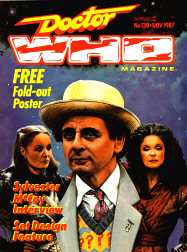 | |  | |  | | | | |  | |  | | | | | | 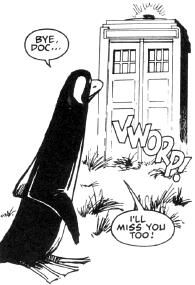 | | | | | | | SCRIPT: Simon Furman
ART: John Ridgway (pencils), Tim Perkins (inks)
LETTERS: Zed
EDITOR: Sheila Cranna ISSUES: 130 - 133
COVER DATES: November 1987 - February 1988
ON TV: Delta and the Bannermen - Dragonfire (Season 24)
REPRINTS: Reprinted as part of the Panini ‘graphic novel’ A Cold Day In Hell, published in May 2009, then in colour in Doctor Who Classics, Issues 1 and 2, published by IDW, in February 2011 - March 2011. Trying to cheer up Frobisher after Peri’s sudden departure, the Doctor lands the TARDIS on the ultimate pleasure planet - A-Lux, except the planet is now covered in snow. The Doctor believes something must have gone wrong with weather control, and he and Frobisher go to one of the automated recreation centres in search of answers. However, inside they find a heat vampire that almost drains the Doctor of his body heat before Frobisher knocks her unconscious. Unfortunately, they are then cornered by Ice Warriors. The Doctor creates a distraction, giving Frobisher enough time to escape with the heat vampire, who is called Olla, but the Doctor is captured. He is interrogated by an Ice Lord called Arryx. The Martians plan to turn A-Lux into a new Mars. Frobisher and Olla are saved by Korr and other survivors of the Ice Warrior attack, but Arryx is horrified when his human lackey Ross tells him that the Doctor is dead. The survivors convince Frobisher to make a perilous journey through the cooling pipes to sabotage the equipment the Ice Warriors have installed in weather control, but Olla must help him by drawing off the heat from the pipe. The Doctor, meanwhile, is far from dead, having put himself in a coma, and now has Ross as a reluctant ally because Arryx will not accept two mistakes. With Frobisher in the pipes, Olla and the survivors are attacked by Ice Warriors. She is forced to release the pipe to help them, but has Frobisher had enough time to get to weather control? Luckily he has, and so has the Doctor and Ross, and the temperature soon starts to rise. Commander Arryx confronts the Doctor as his warriors die, but the Doctor exposes him to the heat from the sun and he dies, ending the Martian menace on A-Lux. Frobisher elects to remain on the planet to help the survivors, but Olla asks the Doctor to take her with him, which he agrees to do. | | | | | 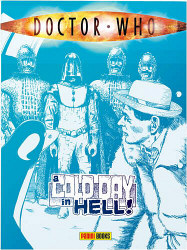 | | | | | | | | 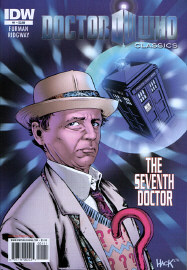 | | | | IMAGINARY FRIENDS - ’FROBISHER’ THE WHIFFERDILL (Part Two) After just one adventure with the Seventh Doctor, Frobisher stays on the planet A-Lux, as he’s missing Peri and feeling redundant aboard the TARDIS. His exit feels hurried and his character a shadow of its former glory, which is a shame as he had arguably been a popular part of the strip and of Doctor Who Magazine itself - even the letters page bore his name. However, this wasn’t quite the end for the Whifferdill who was interviewed in Doctor Who Magazine Issue 148, made cameos in Planet of the Dead and Time and Time Again, then returned in the Eighth Doctor comic strip Where Nobody Knows Your Name (Doctor Who Magazine, Issue 329) where we see he’s set up a bar - Bish's - and married a bird-like humanoid called Caralla, then in the novel Mission: Impractical! by David A. McIntee, and then in to Big Finish audio plays, namely The Holy Terror and The Maltese Penguin, both written by Rob Shearman. He made a further cameo in the Tenth Doctor comic strip Death to the Doctor! In the novel The Scarlet Empress by Paul Magrs, Iris Wildthyme claims she had a shape-shifting companion who often resembled a penguin, but, of course, she may well have been lying... | | | | | | | | |  | | | | | | | 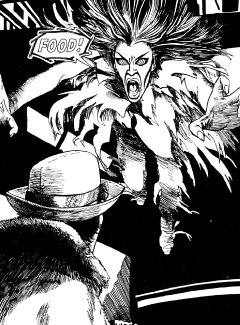 | | IMAGINARY FRIENDS - OLLA THE HEAT VAMPIRE Olla is a Dreilyn, also known as a Heat Vampire, a species that draws body warmth from other creatures in order to survive. Trapped on A-Lux as the Ice Warriors take the temperature down to subzero, the Doctor identifies Olga as particularly hardy. However, she’s also particularly lacking in character, and her sudden decision to ask the Doctor to get her home at the end of the adventure feels forced, even if we do learn in the next story that she’s on the run from the Federation. Once aboard the TARDIS, she acts like the Doctor’s servant, and tells him that her own father sold her into slavery to a cruel man named Skaroux. She claims the Dreilyn are homeless, wandering the universe in decrepit ships, begging for what they need, but it turns out she was Skaroux’s willing consort and fled to A-Lux with most of his money. Skaroux takes her away for trial, and the Doctor doesn’t seem too bothered about it, to be honest. | | | | | | | | | | | SIMON FURMAN SAYS: "My first two Who strip stories had obeyed the unwritten directive 'thou shalt not use established villains straight out of the gate, but with my third story, the first to feature the Seventh Doctor in strip form, I felt a Grade A Who villain was called for.” | | | | | | | | | | TIM PERKINS SAYS: "Working on Doctor Who meant working with John (Ridgway), whose work I really admired, although I’m still not sure I was ready for it, but John was brilliant and lent his advice where it was needed and made me feel I was doing it right. I had a ball on the series and was pretty much left to ink it the way I saw fit.” | | | | | | | | | | ALTERED VISTAS SAYS:
With its use of the Ice Warriors and references to Peladon, A Cold Day in Hell at least tries to be crowd-pleasing, which is more than can be said for the Seventh Doctor’s TV debut. However, the story feels slightly inconsequential and even a little garbled in places, Frobisher’s farewell is perfunctory at best, the artwork feels a little messy at times, and the less said about Olla the better! It’s also odd that Frobisher is mourning the loss of Peri, when on TV Mel has been on the screen for four stories split across two seasons. Did the editorial team have a problem with Bonnie Langford’s character in the show?
| | | | | | | | |
 |  | | REDEMPTION! |
|  |  |  |  | | SCRIPT: Simon Furman
ART: Kev Hopgood (pencils), Tim Perkins (inks)
LETTERS: Zed
EDITOR: Richard Starkings ISSUES: 134
COVER DATES: March 1988
REPRINTS: Reprinted as part of the Panini ‘graphic novel’ A Cold Day In Hell, published in May 2009, then in colour in Doctor Who Classics, Issue 2, published by IDW, in March 2011. The TARDIS is captured and boarded by a Federation ship captained by Skaroux. He is looking for Olla. She tells the Doctor that she was Skaroux’s slave and she escaped his cruelty, but the truth becomes clear when she tries to kill Skaroux. She was his consort and ran away with his money to A-Lux. Skaroux takes her away to stand trial leaving the Doctor alone. | | | ALTERED VISTAS SAYS:
It’s good to see the characterless Olla receive a little development, but as the more interesting stuff is actually fabricated by her, it all feels rather pointless. There is nothing clever, witty or interesting in this strip, and the artwork is adequate at best (despite a lovely first page that evokes the bold style of the magazine’s better artists) and rather amateur and hurried at worst.
| |
| |
 | | |  |
 |  | | STRANGE HILL SCHOOL |
|  |  | | SCRIPT: Unknown
ART: Unknown ISSUE: 2418
COVER DATE: 26 March 1988 The Strange Hill School mob are discussing their favourite television programmes when Eddie, the only member of the class who isn’t a monster, notices that Doctor Who is in town signing autographs. Much to his surprise, his classmates all decide to go with him, but they actually want to have a go at the Doctor for giving all those nice monsters on television a hard time. |
| |
 |  | | ALTERED VISTAS SAYS:
Although the Doctor only appears in two panels, this is rather more than a cameo as the resolution of the plot revolves around the character and what he does. Strange Hill School (taking its inspiration from BBC TV show Grange Hill) was a regular strip in The Dandy.
|
 |  | | THE CROSSROADS OF TIME |
|  |  | | SCRIPT: Simon Furman
ART: Geoff Senior
LETTERS: Zed
EDITOR: Richard Starkings ISSUE: 135
COVER DATE: April 1988
REPRINTS: Reprinted in colour in the Marvel Bumper Holiday Special, Summer 1988, then again in colour in The Incomplete Death’s Head Volume 1 in January 1993, then as part of the Panini ‘graphic novel’ A Cold Day In Hell, published in May 2009, then in colour in Doctor Who Classics, Issue 2, published by IDW, in March 2011. The TARDIS collides with a gigantic bounty hunter named Death’s Head in the corridors of time and both crash on a barren planet. Death’s Head decides to kill the Doctor as he has nothing worth bargaining with, but the Doctor manages to shrink him to human size using the Master’s tissue compression eliminator and then makes a deal: he’ll give Death’s Head his TARDIS if his life is spared. Death’s Head accepts, but the Doctor tricks him and projects him through space and time to Earth in the year 8162. |
|
 |  | | CLAWS OF THE KLATHI! |
 |  |  |  |  | |  |  | |  | | | | ALTERED VISTAS SAYS:
The artwork is hugely improved from previous strips, gorgeously detailed and beautifully toned (and looks even better in the IDW coloured version), and there are also huge improvements in the atmosphere, characterisation and sheer style of the storytelling, though it is never explained how the Doctor knows to investigate at the docks. Foggy London streets, freakshows, London bobbies and Crystal Palace work well to evoke the period, though the ending feels perhaps a little too hurried and the resolution a little too easy, given that the exploding robot removes the need for the Doctor to really do anything. This, despite the above, is still a huge step forward in the quality of the Seventh Doctor’s strip adventures.
| | |  | | | | MIKE COLLINS SAYS: "My initial story was actually about an alien assassination attempt on D'Isreali at the Great Exhibition, but it morphed and developed into something else, as these things do.” | | | |  | |  | |
|  |  | | SCRIPT: Mike Collins
ART: Kev Hopgood (pencils), Dave Hine (inks)
LETTERS: Zed
EDITOR: Richard Starkings ISSUES: 136 - 138
COVER DATES: May 1988 - July 1988
REPRINTS: Reprinted in The Marvel Bumper Comic Issue 1, October 1988 - Issue 6, December 1988, with each instalment divided into two four-page parts, and then as part of the Panini ‘graphic novel’ A Cold Day In Hell, published in May 2009, then in colour in Doctor Who Classics, Issue 3, published by IDW in April 2011. The Doctor arrives in London on the 12th September 1851, and here meets gentleman scientist Nathaniel Derridge who escorts the Doctor to his chambers. He had recently been robbed, as have other members of the New Lunar Society, a group of scientists who meet every full moon to discuss advancements in the field of human learning. Meanwhile, at Wyndham’s Freakshow, Reptillo the lizard that walks like a man has broken free while the telepathic thief Caval has the stolen equipment for his master Danq and Yula, otherwise known as the Satan Twins, who are building a device to return home... The Doctor’s investigations of the thefts at the New Lunar Society reveals that there have also been a series of grisly murders in the city, and the Doctor suspects they were committed with a laser weapon. He goes to the docks to investigate and here finds another victim cut down by laser. However, he and Derridge wander too close to a secret location guarded by a huge robot, and the robot attacks. The Doctor temporarily blinds the robot and discovers a crashed spaceship in the secret location. Getting inside, he realises there are four aliens at large in London. Caval is one of them, and has just finished stealing more equipment for his masters when he is caught trying to take an apple from a stall. The locals give chase and one strikes him down, but Caval begins to glow in a strange manner... Unable to convince the Lunar Society of the truth, the Doctor and Derridge return to Derridge’s chambers, and here find a constable who has brought Caval’s glowing body for inspection. The Doctor deduces that it is some kind of self-healing and is proven right when Caval sits up unharmed. He explains that he is a Joebb and that his people were poor and desperate before the coming of the Klathi Danq and Yula, who raised them up and gave them order and justice. However, the Joebb rose up against the Klathi and Caval, together with his robot Batella, helped them escape in a spaceship. Unfortunately, it warped into the path of a meteor storm and crashed on Earth where Caval and the Klathi took shelter at the freakshow. But they are now almost ready to launch their repaired spaceship. However, the Doctor realises they need the centrepiece of the Great Exhibition at Crystal Palace - Osler’s Crystal Fountain - to reenergise their energy source, and that success would kill thousands of people... The Doctor, Nathaniel and Caval go to the Great Exhibition to stop the Klathi, but they manage to reenergise their energy source and escape. The Doctor’s party follow them back to the spaceship where the Doctor reveals that the Klathi are ruthless exploiters. The Klathi attempt to destroy the Doctor’s group using Batella the robot, but the robot is also programmed to protect Caval and the confusion causes it to explode, destroying the Klathi and their ship |
|
| |
 |  | | CULTURE SHOCK! |
|  |  | | SCRIPT: Grant Morrison
ART: Bryan Hitch
LETTERS: Zed
EDITOR: Richard Starkings ISSUES: 139
COVER DATES: August 1988
REPRINTS: Reprinted in The Marvel Bumper Comic, Issue 9, January 1989 - Issue 10, February 1989, then in colour as part of IDW’s Grant Morrison’s Doctor Who, Issue 1, October 2008, then as part of the Panini ‘graphic novel’ A Cold Day In Hell, published in May 2009, then again by IDW in Doctor Who Classics Omnibus, June 2010, then in colour in Doctor Who Classics, Issue 5, published by IDW in June 2011 (see cover below). The Doctor is feeling depressed and without purpose, until he gains telepathic connection with a cell culture under attack from a virus living within an aquatic creature. He saves the cell culture and returns the creature to the sea, then returns to the TARDIS filled with a new sense of purpose. |
|
 |  | | ALTERED VISTAS SAYS:
Brief, unusual and fairly well scripted, this story is sadly let down by horrible and inconsistent artwork and a likeness of Sylvester McCoy that veers between the just about acceptable (and clearly photo-referenced) and the entirely unrecognisable, though the TARDIS looks very nice... The IDW reprint’s sympathetic colouring job does cover some of the artwork’s worst aspects...
|
| |
 |  | | KEEPSAKE |
|  |  | | SCRIPT: Simon Furman
ART: John Higgins
LETTERS: Zed
EDITOR: Richard Starkings ISSUES: 140
COVER DATES: September 1988
REPRINTS: Reprinted in The Marvel Bumper Comic, Issue 7, December 1988 - Issue 8, January 1989, then in colour in The Incomplete Death’s Head Volume 4, April 1993, and Volume 5, May 1993, then as part of the Panini ‘graphic novel’ A Cold Day In Hell, published in May 2009, then in colour in Doctor Who Classics, Issue 4, published by IDW in May 2011. When a disreputable salvage merchant called Keepsake inadvertently rescues the Doctor from restless alien natives on an inhospitable world called Ryos, he is forced to help in the rescue of a medic but finds he quite enjoys being on the side of good for a change, especially when the medic turns out to be a beautiful and grateful woman... |
|  |  | | |  | | | ALTERED VISTAS SAYS:
Good characterisation and strong visuals (although the Doctor manages to look more like Dexter Fletcher in a hat if he looks like anyone at all) make this an attractive strip, particularly Keepsake and his pet bird. A neat development in Keepsake’s character shows us that the idea of the Doctor showing people the goodness within themselves is not a theme unique to the new series of Doctor Who. This idea is unfortunately rather undone when Keepsake turns up in the Death’s Head strip Do Not Foresake Me Oh My Darling! where he becomes more of a luckless bum, though both his wife (Thea) and his medic girlfriend (Banlia) get names.
|
|
|
 |  | | PLANET OF THE DEAD |
 |  |  |  | | SCRIPT: John Freeman
ART: Lee Sullivan
LETTERS: Zed
EDITOR: Richard Starkings ISSUES: 141 - 142
COVER DATES: October 1988 - November 1988
ON TV: Remembrance of the Daleks - The Happiness Patrol (Season 25)
REPRINTS: Reprinted as part of the Panini ‘graphic novel’ A Cold Day In Hell, published in May 2009, then in colour in Doctor Who Classics, Issue 4, published by IDW in May 2011. The Doctor lands on the planet Adeki looking to indulge in a spot of fishing. However, he soon finds a secret entrance to a subterranean city and with it - Adric! Soon after meeting Adric, he runs into Peri, then Jamie, then Sara, Katarina and Frobisher, all eager to get away in the TARDIS. However, it is soon revealed that they are all monsters called Gwanzulum, disguised and eager to kill the Doctor. The Doctor is saved by... himself - in his Fourth incarnation, who takes him to meet all his other incarnations. It seems the Gwanzulum are the universe’s original shape shifters, predating the Whifferdills and Kymbra Chimera (see here) by many aeons and drawing life energy from their victims in order to change shape. However, the Seventh Doctor realises that all his other incarnations are simply disguised Gwanzulum, tricks his way aboard the TARDIS and then leaves them stranded. | | | | ALTERED VISTAS SAYS:
Celebrating the 25th Anniversary of the series, this strip was extremely popular at the time, but now seems unnecessarily laden with continuity (though the joke where the fake Peri erroneously believes she died is quite a nice touch) whilst simultaneously light on plot. The visuals in Lee Sullivan’s debut Doctor Who Magazine strip are extremely good, with some excellent likenesses (though McCoy’s physiognomy is obviously proving elusive), but the Gwanzulum are perhaps too comical in appearance to ever pose a serious threat. | | | |  |
| |
 |  | | ECHOES OF THE MOGOR! |
|  | |  | | |  | |  | | | ALTERED VISTAS SAYS:
Wonderfully creepy and unusually well-paced despite its brevity, this strip has strong visuals as you might expect from John Ridgway, though the Seventh Doctor here appears to be played by Mr Bean as he never captures McCoy’s likeness at all well. The FHD team are well characterised and clearly defined, though names such as Scott, Cameron, Hurd, Dean Stanton, O’Bannon, Kotto, Cobb and Rambaldi suggest that Dan Abnett was having more than a fleeting love affair with Alien and its sequel at the time. Just to be clear Scott is Ridley Scott (director of Alien), Cameron is James Cameron (director of Aliens), Hurd is a corruption of John Hurt (actor in Alien), Dean Stanton is Harry Dean Stanton (actor in Alien), O’Bannon is Dan O’Bannon (writer of Alien), Kotto is Yaphet Kotto (actor in Alien), Cobb is Ron Cobb (designer of the Nostromo on Alien), and Rambaldi is Carlo Rambaldi (special effects for Alien). Phew!
|
|
|  |  |  |  | | 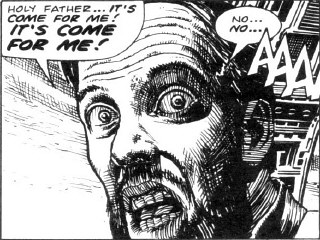 | | | | SCRIPT: Dan Abnett
ART: John Ridgway
LETTERS: Annie Halfacree
EDITOR: Richard Starkings ISSUES: 143 - 144
COVER DATES: December 1988 - January 1989
ON TV: Silver Nemesis - The Greatest Show in the Galaxy (Season 25)
REPRINTS: Reprinted as part of the Panini ‘graphic novel’ A Cold Day In Hell, published in May 2009, then in colour in Doctor Who Classics, Issue 5, published by IDW in June 2011. Heading for Maruthea, the Doctor lands on the storm-battered planet of Mekrom on the edge of known space where he soon discovers the corpse of Dean Stanton, until recently the longest surviving member of a doomed colony awaiting rescue by a Foreign Hazard Duty team. Examining the man’s personal log, which is stored in an empathically absorbent crystal, the Doctor learns that the planet was inhabited by the Mogor about six thousand years before, but that they are believed to be extinct. The FHD team arrive, headed by Hurd, and take the Doctor to be the only survivor of the crew. However, as two of the team head down to the mining level, they are suddenly attacked by a monster... The Doctor and the team head down but are too late to save the men. However, the Doctor discovers that both of them died of shock rather than physical attack. Believing the strange crystal may be a clue, he suggests venturing into the mines, and Commander Hurd agrees. They soon discover a huge seam-face of the same crystal and the Doctor realises that it has recorded an impression of the planet’s former inhabitants - the Mogor are now nothing but ghosts, and he convinces the FHD team of this as a Mogor appears to attack. It vanishes when the Doctor confronts it with its own unreality, and the case is solved. |
|
 | | |  |
 |  | | DOCTOR WHO MAGAZINE ADVERTISEMENT |
|  |  |  | | SCRIPT: Unknown
ART: Unknown ISSUES: 8
COVER DATES: January 1989 The Doctor is fleeing from assorted monsters, including Daleks, Cybermen and Ice Warriors when he realises he has dropped the TARDIS key. Going through his pockets, he finds a copy of Doctor Who Magazine, but it turns out to belong to the monsters who want it back. To make amends, he can buy his own copy in future. | | | ALTERED VISTAS SAYS:
Hardly a subtle advertisement, but one that - if this strip was at all representative - surely wouldn’t help the magazine to sell on the strength of its comic strip!
|
| |
 |  | | TIME AND TIDE |
 |  |  |  |  |  |  |  |  | | SCRIPT: Richard Alan (actually Richard Starkings) and John Carnell
ART: Dougie Braithwaite (pencils), David Elliott (inks)
LETTERS: Tom Orzechowski
EDITOR: Uncredited (which may explain a lot) ISSUES: 145 - 146
COVER DATES: February 1989 - March 1989
REPRINTS: Reprinted in colour in Doctor Who Classics 5, Issue 1, published by IDW in March 2013.
Still hoping to land on Maruthea, the Doctor arrives on the planet Tojana, on the only island which has not yet been swallowed by the incoming tides. The TARDIS is washed out to sea while the Doctor is trying to work out where he is, and he is then captured by the inhabitants of the island, who have accepted their fate and are engaged in a hedonistic final party. Life is now cheap, and the natives slaughter each other at the least provocation. The Doctor tries to convince them that life is still worth living, but eventually gives up on them in disgust and builds a raft for himself. The elderly "Worrier" accepts the Doctor's arguments and joins him on the raft. As predicted, the tides rise and the island is covered by the sea, and only the Doctor and the Worrier survive. The Doctor finds the TARDIS floating nearby, and departs, leaving the Worrier to drift on the tide and greet the uncertain future with hope. | |  | |  | | | | | | ALTERED VISTAS SAYS:
Perhaps taking its lead from the TV series, the comic strip lurches between the great and the ghastly. This strip is ghastly. The tone is ghastly and misjudged. The story is ghastly and just plain wrong. The artwork... well, the artwork is beyond ghastly.
| | | | | | 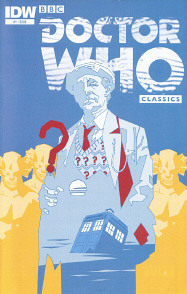 | | |  | | |
 |  | | FOLLOW THAT TARDIS! |
|  |  | | SCRIPT: John Carnell
ART: Andy Lanning, John (Higgins?), Kev (Hopgood?), Dougie Braithwaite, David Elliott
LETTERS: Bambos
EDITOR: Rich (Richard Starkings) ISSUES: 147
COVER DATES: April 1989
REPRINTS: Reprinted in colour in Doctor Who Classics 5, Issue 1, published by IDW in March 2013. The Meddling Monk accidentally materialises his TARDIS - disguised as a portaloo - in the path of a car owned by the Sleeze Brothers, El Ape and Deadbeat, totalling the car. The Doctor arrives to prevent the Monk from fiddling the next Presidential election, the Monk flees. Determined to exact payment for his totalled car, El Ape holds the Doctor at gunpoint and forces him to follow the Monk to Tunguska, 1908, where El Ape sets off a mini-nuke in the Siberian forest to flush the Monk out of hiding. The Doctor then takes his passengers to a liner in the Atlantic Ocean, in 1912, but doesn't realise exactly where he is until El Ape rams the Titanic into a nearby iceberg, believing it to be the Monk's TARDIS in disguise. The Monk's damaged TARDIS lands on an island near Bermuda in 1945, where the Monk is forced to abandon ship. The Doctor drags him to safety and they flee, just as the Monk's TARDIS implodes into the time continuum, causing the passing Flight 19 to vanish into thin air. The Doctor then takes El Ape and Deadbeat back to their own time, and kicks them out before they can cause any more damage to history. |
|
|  |  | | ALTERED VISTAS SAYS:
Oh Lord. Just when you think things can’t get any worse... The Sleeze Brothers were a short lived phenomenon lasting in their own comic between June and November 1989 for just six issues. Their encounter with the Doctor is presumably a taster of what we can expect - and it’s horrible. It’s hard to believe that the two panels printed here are from the same comic strip, but they are - and only a page apart. The script is thoroughly unsubtle and unfunny. The characterisation of the Doctor is virtually non-existent. With this and Death’s Head, it’s like the Doctor’s suddenly become some cheap, painted comic strip strumpet, looking to ply his wares on anyone who’ll have him. It doesn’t work and it never will. Show some respect for a legend!
|
|
 |  | | INVADERS FROM GANTAC |
|  |  | | SCRIPT: Alan Grant
ART: Martin Griffiths (pencils), Cam Smith (inks)
LETTERS: Gordon Robson
EDITOR: Richard Starkings ISSUES: 148 - 150
COVER DATES: May 1989 - July 1989
REPRINTS: Reprinted by IDW in colour in Doctor Who Classics 5, Issue 2, April 2013. A flea-ridden tramp named Alex Trench is hiding in the London Underground, until he is found by the Gantac invasion force who want to know where the treasure of Zantar Wrouth is located. His torture and eventual execution, however, are interrupted by the arrival of the Doctor. The Doctor learns from Alex that it is 1992 and the aliens have overrun the entire planet. |
| |
 |  | | Unfortunately, he is then captured by the Gantac invaders. The Doctor is taken to an internment camp in Hyde Park, but realises when his interrogator asks him the location of the treasure of Zantar Wrouth that the aliens have invaded the wrong planet! He is given communication with the Great Yaga, leader of the Gantac forces back on Gantac, but the Yaga won’t believe him and orders him executed. However, he manages to hypnotise his guard and, with Alex’s help, escape. With Alex suddenly mysteriously unconscious, the Doctor makes it out into the compound then decides to go to the communications centre with a now conscious Alex where the Great Yaga is arriving by matter transmitter. The Doctor proves that the Gantac forces invaded the wrong planet. The Great Yaga attacks him for the embarrassment he has suffered, but is then attacked in turn by Alex’s fleas. Believing himself under attack from invisible forces, the Yaga orders his men to fire, and they do, killing him outright. The Yaga dead, his forces die too, leaving the Earth free once more. |
 |  | | ALTERED VISTAS SAYS:
Some of the most ham-fisted and amateurish artwork ever to grace a Doctor Who comic strip (and that really is saying something) masks a fairly novel idea, even if it is told in largely leaden and occasionally confusing style. I’m not sure who the Doctor looks like in this strip (largely because he seems to change between frames) but it certainly isn’t Sylvester McCoy. Not the greatest way to celebrate 150 issues of Doctor Who Magazine, especially given its past triumphs... This is the first strip where we learn that the Doctor is trying to get to Maruthea for Bonjaxx’s birthday. The ending of the second part of the strip is quite inexplicable, as we get a big close up of Alex Trench looking a little dazed for no good reason.
|
| |
|
 | | |  |
 |  | | TIME BOMB! |
|  |  | | SCRIPT: Steve Parkhouse
ART: Art Wetherell (pencils), Steve Parkhouse (inks), Louise Cassell (colour)
LETTERS: Annie Halfacree
EDITOR: Steve White ISSUE: 8
COVER DATE: July 1989
REPRINTS: Reprinted as part of The Incomplete Death’s Head, Issue 9, September 1993. Josiah W. Dogbolter (see his previous appearances in The Moderator and The Shape Shifter) of Intra-Venus Incorporated plans to bring time travel into the private sector and make it available for everyone through the Dogbolter Temporal Rocket. However, the rocket has yet to be tested, and Dogbolter plans to make that test to settle an old score with the Doctor. He hires assassin Death’s Head, who also has a personal grudge against the Time Lord (see The Crossroads of Time). Death’s Head activates the rocket and, after accidentally landing in Thetford in 1646 where his presence condemns an old woman to death as a witch, the Triassic Period, and just before the Battle of the Somme in 1916, he eventually tracks the Doctor down to a seaside pier in the present day, where the Doctor is playing the fool in an end-of-pier play. Much mayhem ensues, but the Doctor escapes disguised as one end of a pantomime horse and makes off in the TARDIS, but Death’s Head follows him and materialises aboard the ship. The Doctor realises that the rocket is wired with a bomb and Death’s Head makes him track the detonation signal back to Intra-Venus. Dogbolter makes a run for it, but Death’s Head throws the bomb out of the TARDIS, killing him in a huge explosion. The Doctor then drops Death’s Head on top of the Baxter Building, home of the Fantastic Four in Manhattan. |
|
 |  | | ALTERED VISTAS SAYS:
The likeness of the Doctor is atrocious, and quite why the Doctor would be playing the fool in a play is anyone’s guess, but while this strip is low on logic, big on explosions and lacking any feel of Doctor Who, there is some fun to be had, particularly in Steve Parkhouse’s often witty dialogue. But I do wish they’d leave the Doctor out of these crossovers.
|
| |
 | | |  |
 |  | | NEMESIS OF THE DALEKS |
|  |  |  |  | |  | | | | SCRIPT: Richard Alan (plot), Steve Alan (script)
ART: Lee Sullivan
LETTERS: Zed
EDITOR: Richard Starkings ISSUES: 152 - 155
COVER DATES: September 1989 - December 1989
ON TV: Battlefield - Survival (Season 26)
REPRINTS: Reprinted in the ‘graphic novel’ Abslom Daak Dalek Killer, released by Marvel in 1990, then again in Panini’s ‘graphic novel’ Nemesis of the Daleks, April 2013, then in colour in IDW’s Doctor Who Classics Volume V Issue 3 (for parts 1-3) and Issue 4 (for part 4), August-September 2013 Still searching for Banjaxx’s party, the Doctor lands on the desolate planet of Hell and discovers the wreckage of a ship containing a human, a Draconian and an Ice Warrior. However, he is soon cornered by Daleks - that is, until the arrival of Abslom Daak. The Dalek Death Wheel is being built by Helkan slave labour, but the slaves are dying and the Daleks must complete the Wheel to achieve universal domination. Meanwhile, the Doctor and Daak get better acquainted and join forces against the Daleks whereby they discover that the Daleks are mining poison gas. They team up with some of the Helkans to overcome the menace. The Doctor, Daak, and a group of Helkans take a cargo ship up to the Daleks’ Death Wheel but are quickly captured and presented before the Emperor, though Daak somehow manages to avoid capture and learn of the Daleks’ genocide device. But the Doctor is recognised, held by the Daleks and to be exterminated. Daak rescues the Doctor as the Daleks prepare to gas all the inhabitants of Hell. With the surviving two Helkans, they locate the central reactor of the Death Wheel, but Daak won’t let the Doctor sacrifice himself and takes his place while the Helkans get the Time Lord to safety. Daak destroys the reactor, himself and the Death Wheel. |
| |
 |  | | ALTERED VISTAS SAYS:
After seven months of dross, Nemesis of the Daleks at first feels like a real breath of fresh air, but it quickly becomes clear, despite some confident artwork from Lee Sullivan (who, alas, is still struggling to capture a decent likeness of McCoy - just like almost every other artist to have so far worked on the strip), that this is just lots of tedious continuity references (the whole Abslom Daak thing, Ogrons, Emperor Dalek, Davros, a garbled speech from Genesis of the Daleks etc etc) strung together in a bland Star Wars-driven plot about building a Death Wheel/Death Star. It treats the beautifully defined Star Tigers team terribly, killing them all off in a few frames, just to team up the Doctor and Daak with some bland and vaguely annoying locals. There are a couple of strange jumps in the storytelling that really don’t help matters. Oh - and “By the blue vase of ghosts!” has got to be one of the strangest exclamations since the Third Doctor’s comic strip era.
|
|
 | | |  |
 |  | | The Incredible Hulk Presents was a short-lived Marvel comic lasting just twelve issues. It printed original Doctor Who strips, amongst other things, the idea being that these could be reused in Doctor Who Magazine to save money. However, Doctor Who Magazine editor John Freeman was unhappy with this as he was trying to give the magazine strip direction. As it happened, only Hunger from the Ends of Time would be reprinted there... |
 |  | | ONCE IN A LIFETIME |
|  |  | | SCRIPT: John Freeman
ART: Geoff Senior
LETTERING: Stuart Bartlett
EDITOR: Andy Seddon ISSUE: 1
COVER DATE: 7 October 1989
ON TV: Ghost Light (Season 26)
REPRINTS: Doctor Who Classic Comics, Issue 21, June 1994, then again in Panini’s ‘graphic novel’ Nemesis of the Daleks, April 2013 (See above for cover). Relaxing in a park in Solar City on Galactica Minor, the Doctor is harrassed by a reporter who wants the story on the TARDIS. The Doctor first sends him to meet some dangerous men for whom the word ‘Doctor’ is not what they want to hear, then transports the man to safety twenty years into the future - ten years after the reporter’s newspaper went out of business. | | | ALTERED VISTAS SAYS:
The artwork on this strip is generally quite nice looking, with strong and confident use of black and some nice composition. However, it all goes horribly wrong every time there is a shot of the Doctor, who just looks nothing like McCoy and isn’t even stylised in the same way as the other characters in the strip. The story... Mmh, well... I find it hard to believe that a reporter (or indeed anyone) could annoy the Doctor enough for the Doctor to send him into mortal danger with a cheery wave, then rob him of his livelihood and all his friends and family by transporting him twenty years into the future. I know it’s not meant to be taken that seriously, in fact I suspect it’s supposed to be really funny, but it all just feels so wrong that it doesn’t even raise a smile.
|
| |
 |  | | HUNGER FROM THE ENDS OF TIME |
 | | |  |
 |  |  | | SCRIPT: Dan Abnett
ART: John Ridgway
LETTERING: Annie Halfacree
EDITOR: Andy Seddon ISSUES: 2 - 3
COVER DATES: 14 - 21 October 1989
ON TV: Ghost Light (Season 26)
REPRINTS: Doctor Who Magazine, Issue 157, February 1990 - Issue 158, March 1990, and then in Panini’s ‘graphic novel’ Nemesis of the Daleks, April 2013, and then in colour in IDW’s Doctor Who Classics Volume V Issue 4, September 2013 (see above for cover). Travelling to the planet Catalog, greatest library in the universe, the Doctor meets up with a FHD team led by Commander Lumsden. Books in the library are stored across time rather than space, but some kind of bookworm is eating the books. The FHD team plan to flush out the tiny creatures, trap and enlarge them then blast them. However, when they finally trap one, their lasers have no effect. The Doctor realises the creature feeds on energy, so the lasers are making it stronger. He saves them by reversing the power of the trap, which draws off the creature’s energy and kills it. He then takes the FHD team into the library system in the TARDIS where they see thousands of the creatures. However, he soon realises that the creatures are forces of chaos, usually only found feeding on the debris from the Big Bang and the End of the Universe. The library’s immense time field has drawn them here, so the Doctor switches it off and returns all the books to the present, thus ending the threat. | | | | ALTERED VISTAS SAYS:
More big guns and combats from the FHD team. The first part of this strip is just lovely, with plenty of atmosphere thanks to John Ridgway’s detailed art (though he still can’t get McCoy’s likeness), but the second half is just a huge anticlimax. Just as things start to get interesting, the Doctor pulls the plug and the threat is ended, just like that. Now if that had been the first half of the story, then comes the huge twist that the creatures have escaped through into the universe, we’d be heading for something meatier, but this is it. End of story. Bit of a waste.
|
| |
| |
 |  | | WAR WORLD! |
 | | | SCRIPT: John Freeman
ART: Art Wetherell (pencils), Dave Hardwood (inks)
LETTERING: Annie Halfacree
EDITOR: Andy Seddon ISSUE: 4
COVER DATE: 28 October 1989
ON TV: The Curse of Fenric (Season 26)
REPRINTS: Doctor Who Classic Comics, Issue 21, June 1994, and then in Panini’s ‘graphic novel’ Nemesis of the Daleks, April 2013 (See above for cover). The TARDIS breaks down on the planet Bellus IV where the Doctor is immediately captured by Commander Deldran and his men who are fighting a centuries-long war against deadly robots. They take him to their base where they reveal that a scientist called Shellon was working on a neural scrambler to destroy the robots but died before its completion. As the robots attack, the Doctor completes the device and activates it, destroying the robots... but also destroying Deldran and his men who are androids created by the now extinct humans. Deldran thanks the Doctor before he deactivates for good. They could never have used the device themselves. | | |  |
| |
 |  | | ALTERED VISTAS SAYS:
Okay, let’s get the bad bits out of the way first - the artwork on this strip is utterly horrible. It looks like a brave effort by a slightly talented seven year old armed only with a black felt tip pen. There is no depth or sense of movement and the panels do nothing to enhance the story. It looks significantly better reprinted in colour in Classic Comics (and that’s saying something given the low opinion most people have of the colour work in those). And now the good bits - the script’s final twist comes as a real shock and gives the story - which only lasts five pages - a real depth and resonance that it initially didn’t even appear to be aiming for. Script-wise this is probably one of the finest short Doctor Who comic strips ever told.
|
 |  | | TECHNICAL HITCH |
 |  | | SCRIPT: Dan Abnett
ART: Art Wetherell (pencils), Cam Smith (inks)
LETTERING: Stuart Bartlett
EDITOR: Andy Seddon ISSUE: 5
COVER DATE: 4 November 1989
REPRINTS: Doctor Who Classic Comics, Issue 24, September 1994
ON TV: The Curse of Fenric (Season 26)
REPRINTS: Reprinted in Panini’s ‘graphic novel’ Nemesis of the Daleks, April 2013 (See below for cover). The TARDIS lands in Earth-type surroundings where the Doctor is greeted by a man who is extremely pleased to see him, but whose reactions are almost childlike. The Doctor soon find s a hidden computer panel beneath the grass, and pressing a button transports him aboard the bridge of Deep Prove Va Gama, where he discovers the man - Admiral Vayle - in a ‘continual consensual hallucination’ to stave off the boredom of the long mission. However, the programming has failed and the companions he is supposed to be surrounded by have vanished, driving the man mad with boredom. The Doctor has a word with the computer and the programme is repaired. |
|  |  | | ALTERED VISTAS SAYS:
There is a nice idea behind this strip, but it is never fully explored. The Doctor claims the loneliness has driven Vayle mad, but rather than try to find a cure for him, he simply relieves the symptoms and leaves him to his fate. The artwork is vaguely reminiscent of 1950s comic strips, with its slightly simplistic style, and the colourised version in Classic Comics does little to improve it. Perhaps it should go without saying by now that the likeness of McCoy isn’t really a likeness at all.
|
|
| |
 |  | | A SWITCH IN TIME |
 | |  | |  | |  |  |  |  |  | | 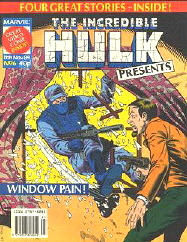 | |  | |  | | | | | | ALTERED VISTAS SAYS:
Give or take the McCoy issue, the artwork here is passable for the type of strip that it is, but the script is puerile rubbish of a type that even TV Comic at their least inventive would have turned their nose up at. There simply isn’t any sense of internal logic to it and the more you try to think about it, the more the whole thing falls apart.
| | | | | | | | | |  | | | SCRIPT: John Freeman
ART: Andy Wildman
LETTERING: Stuart Bartlett
EDITOR: Andy Seddon ISSUE: 6
COVER DATE: 11 November 1989
REPRINTS: Doctor Who Classic Comics, Issue 25, October 1994
ON TV: The Curse of Fenric (Season 26)
REPRINTS: Reprinted in Panini’s ‘graphic novel’ Nemesis of the Daleks, April 2013. Whilst repairing the TARDIS, the Doctor is thrown back as the TARDIS is wracked by a mysterious force. The ship lands and immediately the Doctor is approached by a strange creature called Thyron being pursued by the monstrous Gherax. The Gherax attacks and the Doctor finds himself in a snowy waste where the creature again attacks. However, it soon becomes apparent that all the creatures are working to a script and, as the Doctor beats a hasty retreat to the TARDIS and escapes, it becomes clear that he somehow entered the world of holo-TV. | | | |
 |  | | THE SENTINEL |
 | | | 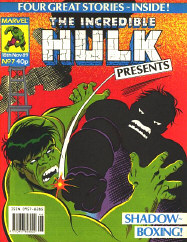 | | | ALTERED VISTAS SAYS:
Actually quite amusing, with much witty dialogue, and the artwork is an improvement on usual standards too.
|
|  |  | | SCRIPT: John Tomlinson
ART: Geoff Senior
LETTERING: Helen Stone
EDITOR: Andy Seddon ISSUE: 7
COVER DATE: 18 November 1989
ON TV: The Curse of Fenric (Season 26)
REPRINTS: Reprinted in Panini’s ‘graphic novel’ Nemesis of the Daleks, April 2013 (See above for cover). The TARDIS strikes a temporal rubicon - like hitting a space-time brick wall - and is forced down onto Earth during the Cenozoic period. Here he meets Seneschal, a superbeing who seeded the galaxy with life and watched it grow through countless millennia. However, he’s a bit miffed as the latest evolutionary development, the culmination of 4.5 billion years of waiting, is incredibly stupid. This development is called man. The Doctor refuses to help him complete his life mission and escapes. However, he soon realises that Seneschal has taken a tissue sample from him and now plans to create a new race called... the Time Lords! |
| |
 |  | | WHO’S THAT GIRL! |
|  |  | | ALTERED VISTAS SAYS:
This strip is actually rather neat, with twist upon twist, though it could have done with another couple of instalments to give it room to develop and turn into something really interesting. The artwork is nice, and the female Doctor’s outfit - a mishmash of items from all Doctors’ incarnations - works well. Her character is also nicely defined as, though she is clearly in it for the money, she genuinely believes Luj to be wrong - and is proven right! It’s a shame she never returned to get her revenge.
|
|
|  |  | | SCRIPT: Simon Furman
ART: John Marshall (pencils), Stephen Baskerville (inks)
LETTERING: Stuart Bartlett
EDITOR: Andy Seddon ISSUES: 8 - 9
COVER DATES: 25 November 1989 - 2 December 1989
ON TV: Survival (Season 26)
REPRINTS: Reprinted in Panini’s ‘graphic novel’ Nemesis of the Daleks, April 2013. The planet Okul is playing host to a peace conference to avert all out war, and the Frovian Prince Luj goes to greet his old friend the Doctor as the TARDIS arrives. However, the Doctor is a changed man - in fact, he’s a woman! Still, she soon gets down to hearing the grievances of the delegates who believe the Frovian opening of the Kollian dimension will endanger them all. Later, though, it becomes apparent that this new Doctor is in an alliance with delegate Ux, intent on starting a war and making a fortune, and that the real Doctor is chained up in the TARDIS. The imposter is called Kasgi, a hired killer, who believes Luj to be a militaristic butcher. However, when she leaves the TARDIS, the Doctor escapes and heads for Luj’s quarters via a secret passage. But once there he overhears Luj talking of enslaving the Kollian dimension. As the treaty is about to be completed, he bursts into the room and declares that he is the real Doctor and that the Time Lords have withdrawn their support of Prince Luj. This leaves Kasgi without a job, but she wonders if maybe Luj would like to put a price on the Doctor’s head... |
| |
 |  | | THE ENLIGHTENMENT OF LY-CHEE THE WISE |
 | | | 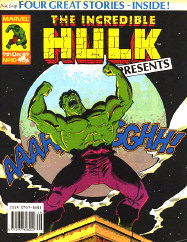 | | | ALTERED VISTAS SAYS:
I don’t like this strip. The artwork is acceptable, there are some very amusing ideas at play, particularly when the Doctor accidentally robs Ly-Chee of his life’s work, but the resolution just doesn’t work to bring the story to a satisfactory conclusion.
|
|  |  |  | |  | | | SCRIPT: Simon Jowett
ART: Andy Wildman
LETTERING: Helen Stone
EDITOR: Andy Seddon ISSUE: 10
COVER DATE: 9 December 1989
REPRINTS: Reprinted in Panini’s ‘graphic novel’ Nemesis of the Daleks, April 2013 (See above for cover). Ly-Chee the Wise has spent thirty winters alone among the mountains of Tora seeking enlightenment, but then saves the Doctor from bandits on the road. He takes the Doctor to his cave and tells him he has spent his life in search of the Holy Number of Nirvana. The Doctor looks at his notes and realises that the number is seven, thus robbing him of his quest. He asks the Doctor for a new puzzle to solve, and the Doctor asks him why the chicken crossed the road. After a week of contemplation beneath an icy waterfall, Ly-Chee demands the answer. It is not the answer he had hoped for and, frustrated, he decides to give up being a hermit and return to the town and real life. The Doctor offers him a lift in the TARDIS, but it takes something of a detour, showing Ly-Chee the wonders of the universe. Finally returned to the town, Ly-Chee goes for a much-needed drink. He has finally become a human being. |
|
 |  | | SLIMMER! |
 | |  | |  | | | | SCRIPT: Mike Collins and Tim Robins
ART: Geoff Senior
LETTERING: Stuart Bartlett
EDITOR: Andy Seddon ISSUE: 11
COVER DATE: 16 December 1989
REPRINTS: Reprinted in Panini’s ‘graphic novel’ Nemesis of the Daleks, April 2013. Having heard strange reports, the Doctor goes to investigate Weight-A-Way, a health club at the edge of the galaxy. After a health examination, he goes to investigate, but is soon captured and taken before the Gromungus, galactic gastronome who is keen to eat the Doctor. However, the Doctor convinces the creature that he would be better left alive as he can use the TARDIS to materialise delicacies from across all time and space. The Gromungus eats so much, though, that it increases its mass to the point of gravitational collapse and implodes into a black hole. Now it will spend all eternity eating the universe... |
| |
 |  | | NINEVEH! |
 |  |  | | 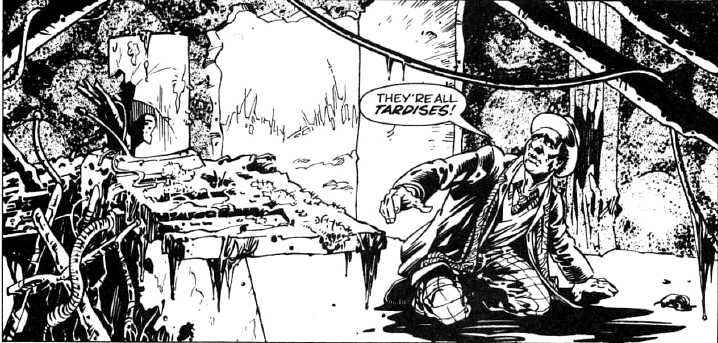 | | | SCRIPT: John Tomlinson
ART: Cam Smith
LETTERING: Peri Godbold
EDITOR: Andy Seddon ISSUE: 12
COVER DATE: 23 December 1989
REPRINTS: Reprinted in Panini’s ‘graphic novel’ Nemesis of the Daleks, April 2013 (see cover above). The TARDIS materialises in an inhospitable landscape of wrecked ships where the Doctor is confronted on the scanner by a figure who declares ‘I am your death!’. Outside he realises the world is located in Null Space, and the ships are all decaying TARDISes, which reminds him of a poem from the Muses of Rassilon. However, the figure soon returns to haunt him with the poem, claiming that he delivers Time Lords at the end of their lives to their deaths. The Doctor flees back to the TARDIS, but the creature follows him and enters the ship through the wall, but as he tries to absorb the Doctor, he realises that the Time Lord is only on his Seventh regeneration (sic) and strong enough to break free, which the Doctor does. | |
| |
 | | |  |
 |  | | STAIRWAY TO HEAVEN |
 | |  |  |  |  |  |  |  | |  | | | | SCRIPT: Paul Cornell (plot), John Freeman (script)
ART: Gerry Nolan (pencils), Rex Ward (inks)
EDITOR: John Freeman ISSUE: 156
COVER DATE: January 1990
REPRINTS: Reprinted in Panini’s ‘graphic novel’ Nemesis of the Daleks, April 2013, and then in colour by IDW in Doctor Who Classics Volume V Issue 4, September 2013. The Doctor, aiming for the Chardaz Museum of Modern Art, lands in a jungle near a gigantic staircase made of bricks and bones. There, he sees an odd creature which hatches from an egg and develops the ability to breath fire within seconds. The creature bakes a brick out of clay from the jungle floor, snaps a bone from one of the hundreds of skeletons scattered about the base of the stairway, and climbs. The Doctor follows it to the top, where he stops it from leaping to its death after it has laid its brick in place. The staircase has nearly reached the roof of the jungle, and the Doctor opens up a panel in the ceiling to reveal that he has materialised inside the latest piece of art by the genetic sculptor Garg Ardonquist, who intends it to symbolise the struggle and sacrifice an artist must make in the process of creation. The Doctor accuses him of torturing his creations in the name of art, but Ardonquist dismisses his boorish criticism. Ardonquist's creation, however, assumes that it has found Heaven and leaps joyously at its creator, and the unprepared Ardonquist topples into the sculpture. He and his creation fall to their deaths at the base of the sculpture. The Doctor escapes back to the TARDIS while the museum's security guards pick up bricks from the stairway, which will now be considered collectors' items | | 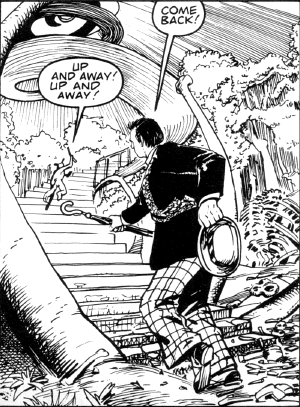 | | | | | |  | | | | | | | | | | 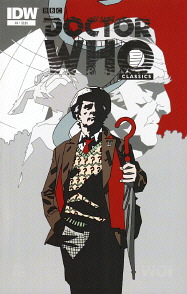 | | | | | ALTERED VISTAS SAYS:
And suddenly we are into the era of the comic strip post-TV series. This strip - written by Paul Cornell in his Doctor Who debut - is quite adult in its theme, quite in keeping with the character of the Seventh Doctor, and quite depressing too. The artwork is okay, and the Doctor does actually resemble McCoy, though it’s not always clear from the pictures exactly what is happening. As a strip, it’s definitely a step in the right direction, but hard to get excited about. Interestingly, the Doctor isn’t trying to get to Maruthea at the start of this story, which he’s been trying to do since December 1988!
| | |
 |  | | TRAIN-FLIGHT |
|  |  | | SCRIPT: Andrew Donkin and Graham S. Brand
ART: John Ridgway
LETTERS: Glib
EDITOR: John Freeman ISSUES: 159 - 161
COVER DATES: April 1990 - June 1990
REPRINTS: Reprinted in colour as part of Virgin Publishing’s ‘graphic novel’ The Mark of Mandragora, June 1993, then again in Panini’s ‘graphic novel’ Nemesis of the Daleks, April 2013, then in colour by IDW in Doctor Who Classics Volume V Issue 5, October 2013. Having left Ace in the Cretaceous Period, the Doctor pays a visit to Sarah Jane Smith and entices her to attend a jazz concert with him at the Albert Hall. However, she will only go if they travel by underground train rather than TARDIS. Unfortunately, the train is caught in a primitive transport dematerialisation, though nothing appears to change due to a hypnotic signal. The Doctor is immediately suspicious, and he and Sarah leave the train to investigate, soon finding many more trains and buses, all from the London area, and all filled with human remains. However, the greatest revelation comes when they realise they are aboard a strange spaceship in orbit around the Earth. Avoiding ejection into space, the Doctor and Sarah investigate further and find the highly advanced insectoid Kalik operating what appears to be a food production line. They are caught and discover that this group of Kalik do not support the peaceful vegetarian policies of their government. They supply red meat on the black market, and humans are that meat. However, the Doctor tricks the Kalik leader into hunting them rather than killing them straight away, but the Doctor and Sarah wander into a hatchery and the Kalik young think they are baby food. Escaping the hatchery and creating a diversion by setting fire to some empty cocoons, the Doctor and Sarah head for the control room. They are almost caught, but at the last moment the Doctor manages to change the hypnotic frequency used to convince the humans that they are still in an underground tunnel so that it neutralises the Kalik’s insect brains. These rebel Kalik will stand trial before their government. The Doctor returns the train to London, unfortunately forgetting that there is no Albert Hall station... |
| |
|
 |  | | DOCTOR CONKERER! |
|  |  | | SCRIPT: Ian Rimmer
ART: Mike Collins
LETTERS: Hel
EDITOR: Andy Seddon/John Freeman ISSUE: 162
COVER DATE: July 1990
REPRINTS: Reprinted in colour as part of Virgin Publishing’s ‘graphic novel’ The Mark of Mandragora, June 1993, and then again in Panini’s ‘graphic novel’ Nemesis of the Daleks, April 2013. Landing in fifth century Britain to pick up some conkers, the Doctor saves some local boys from marauding Vikings and inadvertently invents the game of conkers. | | | ALTERED VISTAS SAYS:
This strip was originally due to be published in The Incredible Hulk Presents Issue 13, but unfortunately it ceased publication with Issue 12. Even more unfortunately, it found a new home in Doctor Who Magazine, as it’s really not very good. In its new home, it even receives something of an apology from John Freeman for its distinctly different tone, with a line introduction supposedly from the Doctor’s diary saying that, ‘The Kalik menace is over but I feel distracted by recent events... I must find a way to concentrate.’
|
| |
 |  | | FELLOW TRAVELLERS |
|  |  |  |  | | 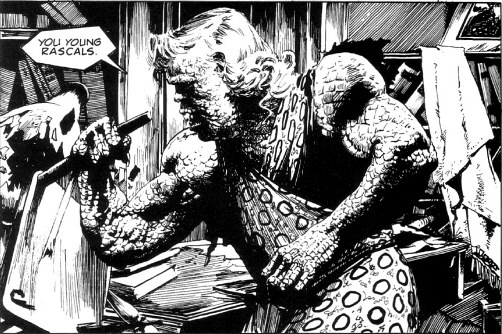 | | | SCRIPT: Andrew Cartmel
ART: Arthur Ransom
LETTERS: Glib
EDITOR: John Freeman ISSUES: 164 - 166
COVER DATES: 8 September 1990 - 31 October 1990
REPRINTS: Reprinted in colour as part of Virgin Publishing’s ‘graphic novel’ The Mark of Mandragora, June 1993. The Doctor and Ace arrive at a creepy country mansion, but go to the keeper’s cottage to warn housekeeper Ella Cooper, her young daughter Lizzie and elderly Mrs Lacy that something is coming that could kill them all. However, when the family cat transforms into a monster, it is Ace who almost dies by its claws. The group barricade the creature outside the room, but are eventually forced to flee to the main house. With the others safely in the main house, the Doctor and Ace go out into the grounds to explore, and there find two police officers. Setting off the police car’s siren, they lure the creature into the car then blow it up, but the Doctor reveals that the creature is a Hitcher, a relentless and aggressive creature from the void, that latched onto the TARDIS. He also reveals that the creatures always travel in pairs. Back in the house, he realises that, if one of the creatures got inside Mrs Lacy’s cat, then the other one probably got inside her, and the proof is soon to follow. The Doctor reveals that the Hitchers can only hitch rides in certain bodies, ones that are filled with potential aggression, anger or rage, and it soon becomes clear that Mrs Lacy is ideal: Ella married Mrs Lacy’s son, dragged him down, mixed her blood with his, which Mrs Lacy thinks is racially wrong. However, when she seizes Lizzie, Ella’s maternal instinct comes to the fore and the rage triggers the Hitcher to switch bodies again, but Ella’s strongest instinct is to protect her daughter - defense not attack, and there it will stay. As they leave, Ace realises that the mansion actually belongs to the Doctor. | |
|  |  | | | ALTERED VISTAS SAYS:
Ace finally makes her comic strip debut, and in a strip written by the television series’ most recent script editor - the first time a script editor has penned related comic strips since David Whitaker in the 1960s. This is a handsome strip with a great atmosphere and striking visuals, and this is harnessed to a story that is both mature and thoughtful, though why the Doctor is so confident that Ella will never encounter anyone more angry or aggressive than her maternal instinct, thus allowing the creature to change bodies once again, is anyone’s guess. Still, the Doctor and Ace are spot on, as you might expect, and you can hear Sylvester McCoy and Sophie Aldred speaking every word of this strip. The idea of the Doctor’s house ties in very nicely with the Third Doctor’s comic strips.
| | |  |
|
|  |  | | IMAGINARY FRIENDS - ACE Poor old Ace - she doesn’t get to appear in the strip until a year and two months after Sophie Aldred’s last appearance in the television series and seems to be forever wearing the same clothes - black leggings and her Ace jacket. To be fair, she fairs better than most of the other companions to have featured in the strip, always given excellent characterisation, and dialogue you could actually hear the character speaking, but it was unfortunate that Doctor Who Magazine eventually decided to fit its stories into the continuity of Virgin’s New Adventures, as this definitely had a detrimental affect on the character, especially for anyone who didn’t happen to read the novels - missing from Ravens for no apparent reason, then ousted in favour of Benny in Pureblood, then mysteriously back again with ponytail, tight trousers and an annoying and un-Ace-like persona for Final Genesis, then gone again for Uninvited Guests. It was a relief when the comic strip finally untied itself from Virgin’s continuity strings (and apparently the continuity of the television series), but what a way to do it - by killing off Ace in Ground Zero, though she did put in one final appearance, sadly in her Virgin meat-head guise, in The Last Word.
|
|
 | | |  |
 | | |  |
 |  | | SCRIPT: John Freeman
ART: Gerry Dolan
LETTERS: Gary Gilbert
ADVICE: Mike Collins and Lee Sullivan
SCRIPT: John Freeman
ART: Steve Parkhouse
|
|  |  |  | | John Freeman and Lee Sullivan first thought of the idea of creating a Doctor Who newspaper strip in the summer of 1989, at a convention in Cardiff, where they asked members of the audience for ideas. These ideas - which involved Daleks, UNIT, Movellans and the Channel Tunnel, were then crafted into a thirteen week story, the usual length of a daily newspaper strip, and intended for publication in The Daily Express. Permissions from the BBC and Terry Nation’s agent were provisionally granted and the first few examples of the strip were created, though Lee Sullivan was by this point too busy working on the art for a Robocop comic, and so was replaced by Gerry Dolan. Perhaps unsurprisingly given the absence of a new television series and the generally low regard that Doctor Who was held in at the time, there were no takers from the daily newspapers, and the only time the strips were ever published was in Doctor Who Magazine Issues 167 - 168. Following the success of the 2005 revival, John Freeman again tried to launch a daily strip in the Daily Mail. This idea was initially approved by the BBC, the first story written and the first three strips illustrated before the BBC changed their mind, believing that a daily strip on top of strips in Doctor Who Magazine and Doctor Who Adventures would lead to confusion. | | | |  |
|
 | | |  |
 |  | | DISTRACTIONS |
 |  | | SCRIPT: Dan Abnett
ART: Lee Sullivan (pencils), Mark Farmer (inks)
LETTERS: Steve Potter
EDITOR: John Freeman ISSUE: 168
COVER DATE: December 1990
REPRINTS: Reprinted in colour as part of Virgin Publishing’s ‘graphic novel’ The Mark of Mandragora, June 1993. Something is troubling the Doctor - they have been drawn again and again to Earth and plagued by creatures that should never appear on the planet - Kalik, Hitchers, Morgaine. Ace, meanwhile, has been exploring the TARDIS, and mentions the Doctor’s study, in actual fact the Secondary Control Room, and this gives the Doctor a nasty idea - what if some essence of the Mandragora Helix remained in the TARDIS following his last encounter with it. They decide to explore the ship together... |
 |  | | THE MARK OF MANDRAGORA |
 |  | | SCRIPT: Dan Abnett
ART: Lee Sullivan (pencils), Mark Farmer (inks)
LETTERS: Steve Potter
EDITOR: John Freeman ISSUES: 169 - 172
COVER DATES: January 1991 - April 1991
REPRINTS: Reprinted in colour as part of Virgin Publishing’s ‘graphic novel’ The Mark of Mandragora, June 1993. It’s the end of the 20th Century in the Falling Star Nightclub in London - in plain clothes Sergeant Jasper Bean and Captain Muriel Frost of UNIT head behind the scenes to investigate. Meanwhile, the Doctor and Ace are investigating the TARDIS, looking for signs of Mandragora energy. Bean and Frost discover a lab for creating the drug known as M or Mandrake, but are found by Stranks, owner of the complex. Bean and Frost escape, but run right into the Doctor and Ace. Bean is seized and killed by a Mandragora creature and the Doctor orders the others to run. |
 |  | | The Doctor, Ace and Muriel Frost escape out of the building and into Frost’s car, but they are observed by Stranks. Back at UNIT HQ, the Doctor’s identity is verified and Frost reveals that UNIT is investigating Mandrake, a huge problem amongst teenagers. The Doctor realises the connection between Mandrake and Mandragora and they head back to the nightclub to investigate. As they sneak in through a vent, the Doctor tells Ace that Mandragora is warping the TARDIS’ dimensions to connect it to this time; if they don’t materialise the TARDIS properly, it will tear itself apart. Inside the factory, they find another Mandrake factory and a huge energy syphon, which begins to crackle with Helix energy. The Doctor shorts out some of the Helix power with his umbrella, then leads Ace, Frost and the UNIT troops to relative safety back in the TARDIS, which is merging with the Falling Star basement. There he uses the TARDIS’ instruments to analyse the Helix and realises that Mandrake makes people susceptible to Helix control. Unfortunately, they are found by |
| |
 | Stranks and taken back to the basement where he explains that the Helix will rejuvenate itself through the Mandrake-taking youth. And as the youths start to change, the Doctor leaps down towards the Helix energy. Frost mobilises UNIT forces, but there is nothing they can do as the Helix prepares to rejuvenate and consume the Earth. The Doctor too is resigned, blaming himself for bringing Mandragora to Earth in the first place. However, just at the moment of the Mandragora’s triumph, it burns itself out, but the Doctor is far from happy - it is clear which part of the Helix failed: the TARDIS. A few days later in UNIT HQ, Captain Frost tells the Doctor that the Helix affair has pushed UNIT into the public eye and there may be a new secret team, perhaps called the Foreign Hazard Duty, and the Doctor agrees to join - at least until the TARDIS materialises: it didn’t disintegrate, only hiccup and jump through time. The Doctor and Ace leave as Brigadier Alistair Gordon Lethbridge-Stewart arrives. |
| |
 | | |  |
 |  | | SCRIPT: Unknown
ART: John Ridgway
COVER DATE: 16 February 1991 Dan Dare and Digby try to get the Mekon and assorted alien nasties to buy red noses for Comic Relief, but it takes the arrival of Doctors One to Seven, plus various companions, to sort out the bounders with red noses filled with yoghurt. |
|  |  | | ALTERED VISTAS SAYS:
Just two pages long but packed with puns plus the TARDIS, all seven Doctors, a selection of classic monsters and even a few companions. Good, light-hearted fun nicely drawn by John Ridgway.
|
|
| |
 |  | | PARTY ANIMALS |
 |  | | SCRIPT: Gary Russell
ART: Mike Collins (pencils), Steve Pini (inks)
LETTERS: Glib
EDITOR: John Freeman ISSUE: 173
COVER DATE: May 1991
REPRINTS: Reprinted in The Incomplete Death’s Head, Volume 1, Issue 12, December 1993. The Doctor finally reaches Maruthea, just as the Sixth Doctor is leaving. There, he finally gives his Daemon friend Bonjaxx a birthday present, and he and Ace meet a future incarnation of himself and his companion Ria. As the two Doctors chat, a drunken Meep starts a bar brawl, and although Ace and Ria enthusiastically participate, the Doctors decide they must be going. But even as these Doctors depart, the Fourth Doctor is arriving... |
| |
 |  | | THE CHAMELEON FACTOR |
 |  | | SCRIPT: Paul Cornell
ART: Lee Sullivan (pencils), Mark Farmer (inks)
LETTERS: Glib
EDITOR: John Freeman ISSUE: 174
COVER DATE: June 1991 The interior of the TARDIS suddenly transforms into a forest, and as the Doctor and Ace climb the tree in the centre of the former console room the Doctor tries to remember what caused this, vaguely recalling that he lost something important during his second incarnation. Visions of past threats appear to him; the Virus from Titan, the Mandragora Helix -- all things which have penetrated the interior of the TARDIS. A raven gives Ace a ring and then transforms into a vision of Sutekh. Ace, surprised, falls out of the tree, as the Doctor, finally understanding, apologises to the TARDIS for his lack of thought. The console room returns to normal, and the Doctor identifies the ring as the one he wore in his first incarnation. It must have fallen inside the console and interfaced with the chameleon circuit, causing untold damage to the TARDIS in the process. He decides to start wearing it again. |
|  |  | | ALTERED VISTAS SAYS:
Perhaps a little heavy on the continuity, and therefore confusing for anyone but the most dedicated Doctor Who fan, but as this issue is a TARDIS special, it can just about be forgiven, I guess. The story is ingenious and well worked out, the artwork handsome and the characterisation as crisp and authentic as we’ve come to expect. A surprisingly readable little strip.
|
|
 | | |  |
 |  | | SEASIDE RENDEZVOUS |
 |  | | ALTERED VISTAS SAYS:
The story is throwaway, a spot of Summer fun, but the artwork is pleasing. Interestingly, this is the first time the comic strip Doctor has been to Blackpool since the TV Comic story The Metal Eaters of either October 1974, or its Fourth Doctor reprint in 1977/1978. Amusingly, the TARDIS in Seaside Rendezvous appears to have landed exactly where the Doctor Who Exhibition had been up until October 1985.
|
|  |  | | SCRIPT: Paul Cornell
ART: Gary Frank (pencils), Stephen Baskerville (inks)
LETTERS: Glib
EDITOR: John Freeman ISSUE: Summer Special 1991
COVER DATE: June 1991 The Irish Sea, 1826. The crew of the Camara cast a large stone overboard, a stone that has apparently already killed three of the crew. Blackpool, present day. The Doctor and Ace are at the seaside, and while Ace wants the Doctor to see a fire that has started on the Golden Mile, the Doctor is busy waiting for something. Something soon arrives, as a creature made of sand rises from the sea attracted by the heat of the blaze. The Doctor persuades the firemen to aim their hoses at it, breaking it down into a heap of sand, then he throws the sand into the fire which it helps to extinguish. |
|
 | | |  |
 |  | | THE GOOD SOLDIER |
|  |  |  | | 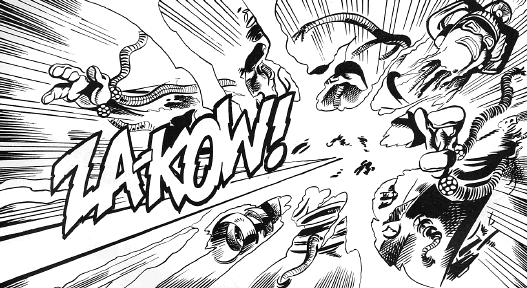 | | | SCRIPT: Andrew Cartmel
ART: Mike Collins (pencils), Steve Pini (inks)
LETTERS: Glib
EDITOR: John Freeman ISSUES: 175 - 178
COVER DATES: July 1991 - October 1991
ON TV: Pilot Episode: An Unearthly Child (repeat) With the TARDIS disguised as a period automobile, the Doctor and Ace are in Nevada 1954. They arrive at the Nevada Star diner to find Colonel Rhodes and his men waiting for visitors. However, it soon becomes apparent that whatever they are waiting for is not coming to them, as a disc of earth containing the diner is transported into space which then docks with an enormous shuttle which then, in turn, docks with a vast warship. And just when it seems things can’t get any worse, Cybermen emerge from the desert sand. Working with the Cybermats, the Cybermen set up a cannon and dig an access shaft. However, while the military plan their next move, the Cybermen and the walking Cybercannon attack. The military retaliates while the Doctor and Ace slip away into the cyber-warship. Colonel Rhodes and his troop, meanwhile, have been captured by the Cybermen, and Rhodes is manipulated through Cybercontrol into killing all his men. This makes him ideal for the Cybermen’s purposes and he is installed as part of the warship. The Doctor and Ace fight back, linking Ace into the same network through the TARDIS, and manage to launch the shuttle craft from the warship. The Cybermen attack and then pursue the shuttle, but as Ace grows more accustomed to controlling the ship, she orders the shuttle’s reserve reactor aboard the escape craft and then launches it. The Cybermen believe they are trying to escape and pursue the escape craft which then detonates, destroying the warship and their new weapon - Rhodes. | |
| |
 | | |  |
 |  | | UNDER PRESSURE |
| |  |  | | ALTERED VISTAS SAYS:
Absurdly contrived but quite fun all the same, this strip could only appear in a Yearbook where the pleasure of seeing three Doctors (almost) together in the same strip whilst also rerunning The Sea Devils in the background just about makes it a worthwhile addition, if only as a feast of nostalgia, which is of course what Doctor Who was in danger of becoming by 1992, with no new series for three years...
|
|
 |  | | SCRIPT: Dan Abnett
ART: Vincent Danks (pencils), Cam Smith (inks), Louise Cassell (colour)
LETTERS: Glib
EDITOR: John Freeman COVER DATE: September 1991 The Doctor tells Ace a story from his past. His fourth incarnation materialised on a British submarine under attack by Sea Devils, and the submarine was then contacted by the Third Doctor, who was co-ordinating the mission from the surface. The Fourth remembered that it was his intention to contact the Sea Devils peacefully, to try to negotiate peace between them and the humans; however, he succeeded only in awakening a species which still desired the eradication of the upstart human race. Now the Fourth Doctor must solve the crisis without alerting his past self to his presence, and thus changing history. Without identifying himself, the Fourth Doctor worked with the Third to translate the Sea Devil transmissions and transmit their own, false message, claiming that the Earth was still under threat. The Sea Devils retreated to their hibernation chambers, and the Fourth Doctor departed before the Third could find out who he was. |
|
 | | |  |
 |  | | A GLITCH IN TIME |
 |  | | SCRIPT: John Freeman
ART: Richard Whitaker
LETTERS: Caroline Steeden
EDITOR: Paul Neary ISSUE: 179
COVER DATE: October 1991 The TARDIS is dragged to a nexus point in prehistory, where the Doctor and Ace meet a group of hunters who believe that nothing they do here can alter the future of the planet. Ace tries to delay them while the Doctor investigates the nexus point, but when the hunters attempt to kill one of the first mammals to evolve on Earth, the Doctor arrives and stops Ace from interfering. A group of time-travelling intelligent dinosaurs then materialises, on a big game hunt from their future -- a future in which the human race never evolved, because these human hunters killed off their own ancestors. But when the lizards tear apart the horrified humans, they all disappear into the nexus. The Doctor explains to Ace that this paradox was self-correcting; history has been restored to what it should be, because the humans were killed by the result of the change before they had the opportunity to cause it. |
| |  | | |  | | | ALTERED VISTAS SAYS:
Clever script hampered by horrible and cluttered artwork.
|
|
 |  | | EVENING’S EMPIRE (1st ATTEMPT) |
|  |  | | SCRIPT: Andrew Cartmel
ART: Richard Piers Rayner
LETTERS: Glib
EDITOR: John Freeman ISSUE: 180
COVER DATE: November 1991 Evening’s Empire almost became the Shada of the Doctor Who comic strip world, with Part One of the strip printed, then... no Part Two. Issue 181 claimed the delay was due to the postal service and reprinted the Doctorless strip Fires Down Below from Issue 64. Issue 182 put it down to ‘the dreaded Deadline Doom’ (whatever that might be) and reprinted the Fourth Doctor strip Spider God from Issue 52. Issue 183 doesn’t mention it at all and prints a one-off Doctorless tale about an FHD team called Conflict of Interests. Issue 184 claims it was due to start a new comic strip called The Grief which had unfortunately been impounded by HM Customs as a suspect device and reprinted the Doctorless Business As Usual from Issues 40 - 43 .We’ll save a plot summary and comment for when Evening’s Empire finally saw the light of day... |
| |
 |  | | THE GRIEF |
 | | | 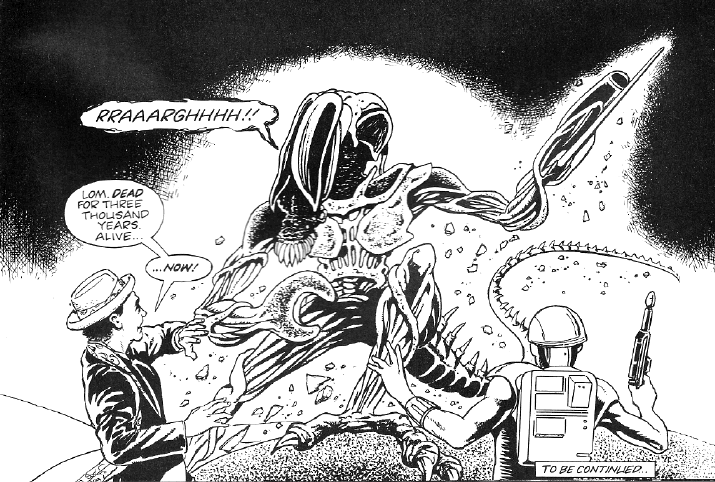 | | | SCRIPT: Dan Abnett
ART: Vincent Danks (pencils), Adolfo Buylla (inks, 1), Robin Riggs (inks, 2-3)
LETTERS: Caroline Steeden
EDITOR: John Freeman ISSUES: 185 - 187
COVER DATES: April 1992 - June 1992
ON TV: The Sea Devils (repeat) The barren ash world of Sorsha is the TARDIS’s next landing spot. The Doctor tells Ace that three thousand years ago, the Sorshans killed themselves and their planet. The Doctor has come to pay his respects to the dead, for the Sorshans were invaded by the Lom and destroyed themselves and the Lom to save the galaxy. The Doctor soon encounters Lieutenant Frethil, of the starship Rosetta, and her Earth marines, who arrests him on suspicion of being an alien spy. Ace sets out to free him but instead meets translator Skrane who is learning to translate Lom script. The Doctor meanwhile has discovered that the humans have uncovered a Lom weapon bearing the inscription The Grief, their ultimate weapon. With Skrane’s translation, Frethil activates the device - and even as she dies, reanimates a Lom warrior. The Doctor escapes, but all others are killed by the Lom. Ace and Skrane are joined by Strauss who says a Condition Red has been called. Meanwhile, the Rosetta calls in - they are being overrun by the Lom. The Doctor appears and tells them that the translation allowed Frethil to activate the Grief, which is a genetic fabrication unit, so every dead human can now produce a new Lom. The Sorshans realised the Lom would be unstoppable, so they activated their planetary shield once the Lom had landed, sealing them in, then released a biological toxin, wiping out everything. They must do the same again before the Lom move in and finish them off. Ace and Strauss hold the Lom at bay for a while as the Doctor and Skrane make their way to the control chamber. Skrane says he will sacrifice himself to destroy the Lom as it was his translation that started it all in the first place, and Strauss stays to protect him. The Doctor and Ace must go and warn the universe about this planet. They make it back to the TARDIS just in time, but Ace is upset by the loss of life and worried that the Doctor knew what would happen all along. She is worried that he no longer cares about individual lives... and worried that he no longer cares about her. |
| |
 |  | | RAVENS |
 | pull into a service station, but there find that a vicious youth gang known as the Ravens have killed everyone at the station and are using the blood in a ceremony to summon a demon. Centuries beforehand, in medieval Japan, a warrior also known as the Raven fails to save his own wife and child from bandits. He slaughters the bandits and waits for death, but the Doctor appears instead and manages to convince him that there are other battles to be fought, other women and children to save. The Doctor takes the Raven to the service station, where the Ravens assume that their ceremony has worked, at least until the Raven himself emerges from the TARDIS and kills them. The Doctor rescues Christine and Demi as the Raven fights the youths, and then stops him from killing Annie, the last of the Ravens. Annie goes forward from that night to tell her story to the other youths of Britain, and remind them about the importance of compassion and mercy. |
 |  | | ALTERED VISTAS SAYS:
This is one of my least favourite Doctor Who comic strips of all time, and for a number of reasons. Firstly, it is extremely pretentious. There are hints of this writing style in Cartmel’s previous srtip The Good Soldier, but not enough to spoil the story, but here it’s like bad Sixth Form poetry on every page - ‘Consider a single snowflake. A single speck of frozen water, like a piece of time frozen for a moment. An intricate pattern.’ And so it goes on. Secondly, nothing actually happens in the second part of the story at all, except restating what happens in the first part, again accompanied by more lurid prose. Thirdly, the moral of the story is apparently about compassion and how compassionate the Doctor is, but it doesn’t seem particularly compassionate to actually plan to let a Japanese warrior slaughter almost everyone in sight. It’s certainly not the way the Doctor would do things. He doesn’t need weapons, be that weapon a gun or a Japanese warrior, so the whole resolution presented here feels totally wrong, not to mention the fact that he clearly knows what will happen to Christine Jenkins and her daughter, and all the poor people in the service station, but does nothing about it until after the event. No, sorry, but this strip is just horrible and leaves a nasty taste in the mouth.
|
 | | |  |
 |  | | METAMORPHOSIS |
 |  | | SCRIPT: Paul Cornell
ART: Lee Sullivan (art), Louise Cassell (colour)
LETTERS: Annie Halfacree
EDITOR: John Freeman COVER DATES: September 1992 The Doctor and Ace materialise on a cargo ship carrying genetically blank human embryos to Earth, where they will be imprinted with the genetic codes of their foster parents, but some embryos have disappeared, and the captain has arrested the ship's medic, Harding, believing he intended to sell them on the black market. However, Harding has lost his mind, having been traumatised by a recent experience, and the Doctor points out that the glass from the embryos' containers was broken from the inside. He senses something happening to him and realises that his own body tissues are changing in response to a signal being beamed at the ship. He has the captain activate the distress beacon, which blocks the signal and forces a party of Daleks to attack the ship in response. Ace manages to shoot and kill one, but the others seize the ship. The Doctor and Ace surrender, and the Daleks recognise him and have him confined to the medical bay while they deactivate the beacon. As the Doctor suspected, the Daleks are transmitting a signal that is mutating the blank embryos into Dalek hybrids, and his own regenerative abilities have rendered him susceptible to the signal as well. The Daleks depart, leaving the Doctor to turn into a Dalek, but the Doctor turns this against them by forging a telepathic link with a hybrid embryo. The embryo enters the Dalek casing which Ace damaged earlier, pilots it back to the Dalek ship and collides with it, destroying the Dalek threat. |
|  |  | | ALTERED VISTAS SAYS:
Some pretty good artwork is hindered by flat and unsympathetic colour and a storyline that always feels slightly shallower and less developed than it needs to be to make this work. The Daleks’ plan is a fairly simple and moderately ingenious one, and there is much to enjoy in this strip, but the resolution never feels quite satisfactory
|
|
 | | |  |
 |  | | MEMORIAL |
|  |  | | SCRIPT: Warwick Gray
ART: John Ridgway
LETTERS: Kid Robson
EDITOR: John Freeman ISSUE: 191
COVER DATE: October 1992 The Doctor takes Ace to the English village of Westmouth, to meet the elderly Simon Galway at the village war memorial. Simon is drawn to the memorial by dreams of a world dying in fire and memories of his brother's death during the Second World War. The Doctor reveals that Simon has been dreaming of the Telphin, a race of artists accidentally slaughtered by the warlike Chaktra due to a garbled intelligence report. The |
| |
 | last work of art constructed by the Telphin psycho-sculptors survived, and the Doctor brought it here to rest and grow in strength; but as it required a living host, he implanted it in the mind of the young Simon Galway. The seed has now matured, and it separates from Simon and manifests itself as a spirit of peace. Simon thanks the Doctor for his gift as the Telphin life force departs. |
|
 |  | | CAT LITTER |
|  |  | | SCRIPT: Marc Platt
ART: John Ridgway
LETTERS: Caroline Steeden
EDITOR: John Freeman ISSUE: 192
COVER DATE: October 1992 While Ace cleans up the TARDIS, the Doctor studies the ship's plans and ponders how best to conduct repairs. Fed up with the Doctor ignoring her, Ace heads for the console room, where she notices a map of the TARDIS on the scanner. She considers getting rid of some of the redundant rooms and is shocked when the rooms delete themselves, apparently at her whim. The reconfiguration runs out of control and Ace scrambles through the TARDIS as it restructures itself around her. As the changes settle down, she finds herself in an unfamiliar bedroom, where the Doctor finds her and informs her that she wasn't responsible for the changes; he had set the TARDIS on a random reconfiguration mode to shake things up a little. And for some reason, it has deleted Ace's bedroom and put a new one in its place, almost as if it is planning for the future... |
| |
 |  | | ALTERED VISTAS SAYS:
This strip is visually striking, thanks to John Ridgway getting a rare chance to cut loose from the bonds of reality. We get to see the Bathroom (complete with note from Frobisher) and the Power Room from The Invasion of Time, a model of the USS Enterprise lying amongst the junk aboard the TARDIS, and there are even a couple of nods to Alice Through The Looking Glass and a funny pun about the Osirians from Pyramids of Mars. However, story-wise this is just tying up loose ends for Virgin’s New Adventures, and if you didn’t happen to read them, then this strip just looks very nice but means very little. What also is the significance of the title? Is it some sort of reference to the New Adventure Cat’s Cradle?
|
 |  | | FLASHBACK |
|  |  | | SCRIPT: Warwick Gray
ART: John Ridgway
LETTERS: Alan O’Keefe
EDITOR: Gary Russell COVER DATE: November 1992 The Doctor shows Benny a recording of an event from Gallifrey's past. A Time Lord named Magnus had found a sphere composed of artron energy, and brought it into real space with the intention of draining it and providing Gallifrey with an inexhaustible power source. His old friend Thete, now a bitter rival, arrived to observe, realised the sphere was alive and that the energy drain was killing it. Magnus refused to stop, Thete destroyed the station's equipment, and released the sphere. The Doctor tells Benny that after much deliberation the Time Lords commended Thete on his actions, but any hope of reconciliation between Thete and Magnus died, and they have been enemies ever since. |
| |
 |  | | ALTERED VISTAS SAYS:
Another special gets another special comic strip, but I don’t feel that this is a story that needed telling as it robs the series of a little of its magic and imagination. Nice visuals, but it all could have been played more subtly, or not played at all...
|
 |  | | IMAGINARY FRIENDS - BERNICE SUMMERFIELD Bernice is a thirty-year-old archaeologist born in the year 2540 who sometimes falsely claims to have a degree from Heidelberg University. She is the daughter of Admiral Isaac Douglas Summerfield, a high-ranking Spacefleet officer, and Claire Summerfield, who died when Daleks attacked their homeworld of Beta Caprisis. She has not seen her father for many years and has spent much of her life searching for him. But, unfortunately, you won’t learn any of this from the Doctor Who Magazine comic strip. Bernice is treated rather like the Doctor’s TV companions, who simply appear in the strip then disappear just as suddenly, but the problem is - unless you read Virgin’s New Adventures from Paul Cornrell’s Love and War onwards - you’d have no idea who she was, and the comic strip really doesn’t give us much to go on. We learn that she likes a drink, has a keen sense of humour, acts as a buffer between the Doctor and the newly stupid, gun-toting version of Ace, is brave, courageous and occasionally headstrong, but frankly not much else. During her comic strip adventures, she helps the Doctor unite the Sontarans and their pureblood cousins by tricking a Rutan spy, has her mind controlled by Davros and the Daleks, convinces Abslom Daak to forget about Taiyin (though he ends up falling for her instead), discovers the identity of the Silurian scientist Mortakk by being |
| |
 | mind-linked to a soldier under his control, meets the Second and Fourth Doctors as she, Ace and the Doctor locate the segments of the Key to Time, and takes 19th Century palaeontologist Mary Wesley to discover an important fossil on the beach at Lifton (despite the Doctor expressly asking her not to). She makes two return appearances, helping the Doctor with the computer known as Xenith and finally, and perhaps fittingly, in a strip celebrating (and lightly spoofing) the New Adventures, where she joins an Eighties pop band to help the Doctor once again defeat the Timewyrm. Of course, away from the comic strip, Bernice would continue to enjoy popularity - becoming first the main character in Virgin’s Doctorless New Adventures, then in a series of books from Big Finish entitled Professor Bernice Summerfield, before making the transition to audio plays also courtesy of Big Finish, as well as appearances in several short stories in the Short Trips collections. |
 |  | | PUREBLOOD |
 |  | | In the 26th Century, Sontara finally falls to the Rutans and Marshal Stave gives the order to evacuate, with priority given to getting the racepool to safety. Meanwhile, the Doctor and Bernice land aboard a space station in orbit around the planet Pandora called the Pandora Spindle, a medical research facility owned by the Lauren Corporation. They are soon discovered, but the arrival of the Sontaran ship stops any further questions. The Sontarans enter the station and assume control, locking Chief Lora and her crew, including the Doctor and Bernice, in Storage Bay 14, while they unload the racepool ready for installation in the Spindle’s genetic workshops. However, an unloading accident kills Sontaran geneticist Denx, forcing the Sontarans to ask the humans for help. But there is a Rutan agent aboard the ship - Modine, and he contacts Rutan Command: the fleet is on its way. The Doctor assists the Sontarans as he does not want to see the galaxy overrun by the Rutan, but Modine tries to stop him. The Marshal shoots him but the Doctor prevents him from destroying the Rutan agent. He imprisons the Rutan in an electrical dampening field and interrogates it. The Rutan plan was to destroy Sontara and the racepool, but in the event that the racepool was taken to safety, Rutan agents were posted to all likely destinations. The Rutan fleet is en route... with its Sontaran allies who helped destroy Sontara. It seems the Rutan discovered a Sontaran colony that had lived in isolation for centuries, from before the time of the Rutan-Sontaran war. These Sontarans are purebloods, untainted by cloning, and furious at what their race has become. As the Doctor and Stave talk, the purebloods begin their attack. Stave prepares to attack, but the Doctor convinces him that there may be a peaceful solution. He travels by TARDIS to the pureblood ship, but the pureblood Sontarans do not believe him when he says the Rutans are the Sontarans enemies and that they are being used as pawns in the war - which is as he suspected. He opens a vid link to the Brig of the Pandora Spindle, where he has sent Benny to speak to the Rutan agent. She gets him to reveal that the purebloods will be disposed of once they have served their purpose, which is enough to convince the purebloods they have been misled. The Doctor takes their Marshal Vord to meet Stave and peace is established. Pandora will become the new Sontaran breeding ground and, together, they will make the Sontarans strong again. |
 |  | | ALTERED VISTAS SAYS:
Amazingly, Pureblood is only the second time that the comic strip Doctor has encountered the Sontarans, the previous occasion being in the Fourth Doctor strip Dragon’s Claw way back in Issues 39 - 45. The Sontaran homeworld in Pureblood is called Sontara, which may seem strange by today’s standards, but is the name given in the novelisation of The Time Warrior - specifically in the prologue written by Robert Holmes - and in the Virgin Missing Adventure’s novel The Crystal Bucephalus by Craig Hinton. This is a very strong story with good characterisation, particularly for the Sontarans and the Doctor. The humans are perhaps less well developed, and the constant use of the word Cruk as an expletive is slightly annoying, but they serve their purpose in an action-packed and well-written story that again puts the Doctor Who comic strip at the top of its game. You can see their next encounter with the Doctor here. By the way, the first part of this strip identifies the century as the 26th, while the second part states 25th. Oops!
|
 |  | | EMPEROR OF THE DALEKS |
|  |  |  |  | |  | | | SCRIPT: Paul Cornell
ART: Lee Sullivan, Marina Graham (colour, Issue 200)
LETTERS: Annie Halfacre
EDITOR: John Freeman ISSUES: 197 - 202
COVER DATES: March 1993 - August 1993
ON TV: The Caves of Androzani (repeat), Revelation of the Daleks (repeat), Battlefield (repeat) Following events in Revelation of the Daleks, Davros is tried and sentenced to death by the Dalek Emperor on Skaro. Meanwhile, the Sixth Doctor and Peri land on Skaro under cover of an asteroid strike and, attacking the Daleks’ systems with a computer virus, rescue Davros and take him away from Skaro. The Daleks swear revenge, and their tool for exacting it will be Abslom Daak, who did not die blowing up the Dalek deathwheel. About to plunge into the reactor aboard the Dalek deathwheel, Daak is transmatted to safety. He finds himself in what appears to be a courtroom on Earth where he is given a mission to find the Doctor. Taiyin is used to pressure him into accepting. Meanwhile, the Doctor and Benny have landed on Hell where they find the Star Tigers Salander, Harma and Vol Mercurius very much alive. However, Daak arrives and seizes the Doctor, and seconds later the whole Star Tigers camp is transported back to the courtroom. But the Doctor is suspicious, especially when the officials ask for the location of Davros, and soon discovers that the officials are robots and the courtroom is really on Skaro. | | | 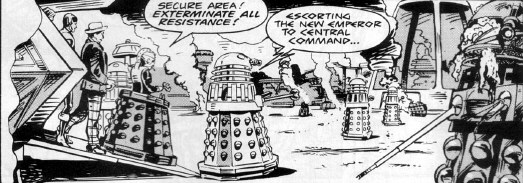 | | | | With Taiyin taken away, Daak goes on the rampage, giving the Doctor enough time to get them all to safety in the service ducts below the city. They head for Taiyin and the Doctor explains that he is here to connect events from his own past. However, when they find Taiyin, the Daleks have rigged a gas trap inside her corpse and they are all captured. | |
| |
 | Benny, Daak, Salander, Harma and Mercurius are locked in a Dalek containment cell, but the Doctor is taken for interrogation. He is forced to reveal Davros’ location, and his full support is assured by the mind control devices fitted to his friends. The Doctor and his mind controlled friends accompany the Dalek taskforce across space. The ship lands on a jungle world and the Doctor leads them, despite hostile vegetation, to a pyramid made of ice. Davros emerges from it but refuses to surrender to the Daleks because the planet is Spiridon and Davros has re-engineered the four million Daleks frozen there as his own personal army. Fighting breaks out between the two factions of Daleks, and the invisible Spiridons join in to help free the Doctor and his companions. Davros’ forces outnumber the Daleks from Skaro and they are forced to retreat to their saucer, but Benny, Mercurius, Daak, Salander and Harma blow the saucer up. However, they are all soon recaptured and Davros wants revenge of the Dalek Emperor. He demands that the Doctor give him the computer virus that he used on Skaro and details of the Hand of Omega (which the Doctor has been dropping hints about) or he will kill Benny. Davros and his Daleks return to Skaro. Activating the virus gives him swift victory and a final confrontation with the Dalek Emperor leads to the Emperor’s destruction, but when he turns on the Doctor’s retinue, Daak attacks him with his chainsword, cutting him in two. The Doctor then reveals that reusing the computer virus was a mistake - used once it freezes the Daleks’ security systems, but twice it signals the central power core to self-destruct. He and his companions depart in the TARDIS as the Dalek city explodes. Later on Paradise the Doctor explains that Davros will eventually rebuild Skaro and seek out the Hand of Omega, thus leading into events that he has already lived through. |
 |  | | ALTERED VISTAS SAYS:
Welcome to the continuity fest to end all continuity fests! Not only does this attempt to tie up continuity between Revelation of the Daleks and Remembrance of the Daleks (taking in Planet of the Daleks and even Survival en route), but it also draws in the comic strip Nemesis of the Daleks, mentions the Thals having relocated to another planet (so they don’t get blown up in Remembrance), Frobisher, Ka Fariq Gatri (the Dalek name for the Doctor), and depicts a Dalek city lovingly redrawn from the one seen on screen in The Daleks. That it actually manages to tell a coherent story is something of a small miracle, and that it turns out to be quite an exciting story is even more astonishing. My only problem with the strip, aside from all the continuity, is the characterisation of the Star Tigers, who don’t feel at all like their old selves (it’s hard to believe, for example, that Prince Salander of the royal Draconian court would become a hardened drinker) and whose explanation of how they survived Nemesis of the Daleks takes some believing.
|
 | | |  |
 |  | | EVENING’S EMPIRE (2nd ATTEMPT) |
 | |  |  |  | | | 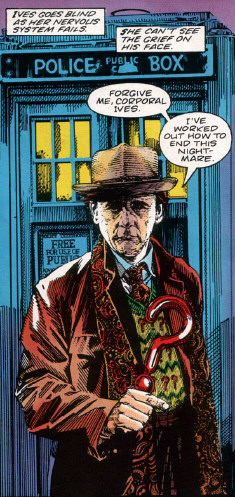 | | SCRIPT: Andrew Cartmel
ART: Richard Piers Rayner, Paul Vyse (colour). Vincent Danks (inking assistance)
LETTERS: Caroline Steeden and Annie Parkhouse
EDITOR: John Freeman ISSUE: Autumn Holiday Special 1993
COVER DATE: August 1993 The Doctor takes Ace to Middlesbrough, where she checks property records from the 1940s while Colonel Frost of UNIT dredges the canal for a German fighter which was apparently shot down during WWII. The Doctor builds a machine which enables her to communicate with the dead pilot's mind, and she confirms that, as the Doctor had suspected, the crash was caused by a collision with an alien spacecraft. Now they must find out what happened to it. Ace still hasn't returned, and when the Doctor visits the property records hall he becomes suspicious of the young clerk Alex Evening. He follows Evening to his home, a shed just outside his mother's house, where he finds that Evening has been using the minute crashed spaceship to kidnap women and place them in his own fantasy world. The Q'Dhite explore the Universe, seeking out new intelligences and weaving realities from their fantasies, but Alex has twisted their powers to kidnap beautiful women and send them to an imaginary empire where they are forced to humiliate themselves for his amusement. The Doctor uses the TARDIS to take Frost and her troops into Evening's empire, but the UNIT forces are slaughtered by Evening's secret weapon - a flying Bible created from his deep-rooted fear of his mother's obsessive faith. The Doctor finally realises how to stop him, and uses the TARDIS to transport Alex's mother into his fantasy world. Her presence destroys the illusion, both figuratively and literally. The Doctor takes the survivors back to the real world, where they find that the destruction of Alex's empire has driven him into a coma from which he will never recover. | | | |  | | | | | | ALTERED VISTAS SAYS:
Photo-referencing is a great way to get good likenesses of your players in a comic strip, but here it’s taken to such absurd lengths that it all starts to resemble one of the World Distributor annuals from the late 1970s, where nobody seems to be connecting with the rest of the players or what’s going on around them (Alex Evening, for example, has his mouth wide open in almost every single panel). The colouring isn’t always particularly sympathetic either, such as Muriel Frost’s vivid magenta hair, or Ace’s lips, which in one panel are the same colour as the handle of the Doctor’s umbrella. This is a shame as it greatly detracts from the strip and an interesting and unusual story, even if the writing does occasionally stray dangerously close to the pretentious in the purple-prose boxes between the dialogue. The characterisation is particularly good, especially for the Doctor, a key feature of Cartmel’s comic strips where the plot is driven by character and theme rather than event, and he also gets good mileage out of the contrast between the humdrum and the fantastical. My only wish is that the artwork worked with the story rather than fighting against it.
| | |
 | | |  |
 |  | | FINAL GENESIS |
 | | | 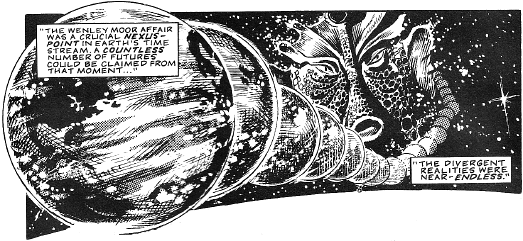 | | | SCRIPT: Warwick Gray
ART: Colin Andrew
LETTERS: Janey Rutter
EDITOR: Gary Russell ISSUES: 203 - 206
COVER DATES: September 1993 - December 1993
ON TV: Planet of the Daleks (repeat) As Colonel Muriel Frost heads for the United Races Intelligence Command headquarters, the TARDIS lands with an unexpected sound in a wood. Frost arrives in the URIC compound and is taken to meet Professor Thactus, a Silurian scientist who has been working on a device. However, reports are coming through of an attack on a Sea Devil base in Japan. The Doctor’s party observe the compound, but are soon caught up in an attack by strange creatures called Chimeras. Ace dives in to help, but it is Thactus’ device that renders the creatures immobile. However, Muriel Frost then turns on the Doctor, Benny and Ace. She doesn’t know them at all. The Doctor explains to Ace that they are on a parallel Earth, one where mankind and the Silurians live in peace. Frost doesn’t believe him: the Doctor and Brigadier Lethbridge-Stewart were killed in a bomb attack two months ago. However, both she and Thactus are convinced when the TARDIS is found in the woods, as they already have the Doctor’s TARDIS in storage within the compound, and Thactus explains to the Doctor that the Chimeras have been attacked remote human, Silurian and Sea Devil bases for two months. He also reveals that the creatures are an amalgamation of human and reptile genetics. The Doctor returns to the TARDIS with Thactus for equipment to help in analysing the creatures, but the URIC soldier accompanying them reveals that she is controlled by another. She aims her gun at the two scientists. The Doctor attempts to hypnotise the soldier out of her conditioning, but it is Benny who saves the day. Meanwhile, the Doctor’s opponent realises that the Doctor has the upper hand and accelerates something called the Genesis. The Doctor mind-links Benny to the soldier and she discovers that the one behind the operation is a Silurian named Mortakk, who Thactus reveals to have been a brilliant but amoral scientist believed to have been executed by the Silurian triad. But Benny also got a location: Darkmoor, and Thactus knows there is an abandoned nuclear research centre there. The TARDIS travels to Darkmoor, but the Doctor, Thactus and Benny are immediately captured by Chimeras and taken before Mortakk. Mortakk believes that all three primary races on Earth - human, Silurian and Sea Devil - have reached an evolutionary standstill. Through the use of a mutagenic gas, he will transform all three into Chimeras, creatures capable of living in any conditions. But the gas will only transform 20% of the population, the rest will die. At the Doctor’s signal, the second TARDIS arrives with Ace and Frost aboard armed with Thactus’ device, but Mortakk escapes in the confusion pursued by the Doctor. Mortakk attempts to kill the Doctor using the power of his third eye, but the Doctor uses his umbrella to puncture a canister of mutagenic gas. It does not affect the Time Lord, but Mortakk is reduced to a pile of bones. |
| |
 | | |  |
 |  | | MIND MEET! |
|  |  | | SCRIPT: Dan Abnett
ART: Simon Coleby (pencils) ISSUE: 12
COVER DATE: December 1993 Forcibly transported to Maruthea, and having relived in Cyberspace various adventures (ie. reprints) including in no particular order Party Animals, Keepsake, The Crossroads of Time and Time Bomb!, Death’s Head II meets up with his former self and discovers that the Doctor was responsible for bringing him here to close off a nagging portion of his past that would otherwise have destroyed him. |
| |
 |  | | ALTERED VISTAS SAYS:
Unless you are completely conversant with Death’s Head complex, convoluted and complicated history, this linking story and many of the reprints embedded within it will probably leave you cold. They certainly leave me cold. For those not in the know, Death’s Head was an unscrupulous assassin-for-hire who would happily kill anyone for cash. Perhaps unsurprisingly, the Doctor sits very badly within the Death’s Head universe and his invitation to Death’s Head’s companion Tuck (a woman with very large hair who dresses like a stripper from the 1980s) is thankfully not taken up.
|
 |  | | TIME AND TIME AGAIN |
|  |  |  | | SCRIPT: Paul Cornell
ART: John Ridgway, Paul Vyse (colour)
LETTERS: Janey Rutter
EDITOR: Gary Russell ISSUE: 207
COVER DATE: December 1993 | | | ALTERED VISTAS SAYS:
Shallow and fannishly indulgent, perhaps, but serving its purpose of celebrating the Doctor’s Thirtieth Anniversary with a fun jaunt around the universe all in ten pages.
|
|
 |  | | The Black Guardian changes history so that the Doctor never left Gallifrey, and, as a result, Earth is now a battleground overrun by alien species. To put matters right, the White Guardian gives travel rings to the Doctor, Ace and Benny, and sends them in search of the six segments of the Key to Time, which scattered along the Doctor's personal timeline when he disassembled the key. Benny takes the Second Doctor's hat from the Land of Fiction, and a jelly baby from the Fourth Doctor as he flees the Mandrels on Eden. Ace fences with the Third Doctor in Sir Reginald Styles' home, and departs with his sword; then catches a cricket ball hit out of bounds by the Fifth Doctor at Lord Cranleigh's match. The Doctor himself takes the cat badge from the Sixth Doctor, then saves his first incarnation from a Dalek while taking the TARDIS manual. Once the six segments are reassembled, the White Guardian puts history right. |
| |
 |  | | CUCKOO |
|  | | |  | | | SCRIPT: Dan Abnett
ART: John Ridgway
LETTERS: Janey Rutter
EDITOR: Gary Russell ISSUES: 208 - 210
COVER DATES: January 1994 - March 1994 It is October 13th 1855 and Doctor Thomas Gideon, fellow of the Royal Society, is travelling by stage coach to the coastal village of Lifton to meet palaeontologist Mary Wesley. His travelling companion, Mr Mackley, regales him with tall stories about hauntings caused by the ungodly woman. When the coach abruptly halts, the driver blames a spectre and Gideon, incensed by the continuous slurs against the woman, gets out to scotch the story. However, he sees something and screams, and the coach drives on without him. Mackley takes up residence in the local inn, where the Doctor, Ace and Bernice soon appear asking for directions to the Rectory where the Wesleys reside. However, the locals are unwilling to help. On the beach, the Doctor reveals that they are there to attend a dinner party held by Mary Wesley‘s father, the Reverend Wesley, and that in attendance will be Doctor Thomas Gideon and Sir William Gadling as Mary unveils the most important paleontological discovery of any era. But they are there to stop her... Despite Ace and Benny’s cries of chauvinism, the Doctor explains that Mary has found the fossilised remains of an alien life form, which he shows them. It could put science back centuries as the scientists attempt to fit this ‘missing link’ into what they know. Ace refuses to help, but Benny agrees, and she and the Doctor go to the Rectory where they are welcomed in as fellow scientists and introduced to Mary, Sir William Gadling... and Doctor Thomas Gideon. Whilst Ace discovers the badly mutilated body of Doctor Gideon on the beach, the Doctor confronts the man, who quickly reveals his true alien nature. The Doctor is saved by Ace’s timely arrival, as she smacks the alien across the head with a fossilised hippo femur. Benny, meanwhile, calms the upset Mary and takes her out for a walk. When the alien recovers consciousness, it reveals itself to be a shape-shifting Surcoth who has come to claim the bones of his ancestor, but his arrogance and indifference to the death and suffering he has caused means the Doctor will not help him. When he breaks free, the Doctor threatens to destroy the bones, but Scuroth begs him not to. The Doctor teaches him a lesson in compassion and understanding ‘lesser’ species, then allows him to take the bones. Mary returns in a state of excitement - she’s found a huge fossil on the beach... one that Benny led her straight to. |
|
 |  | | ALTERED VISTAS SAYS:
Good grief! A story written by Dan Abnett that doesn’t involve big guns and Alien-style set pieces! Wonders will never cease. And the first story since October 1992 that doesn’t feature old enemies. How refreshing! This is dripping in atmosphere, particularly in its first instalment, thanks to Ridgway’s detailed artwork, but it is also extremely wordy and not a little confused in its final part. The time travellers are in Lifton precisely to stop Mary making a discovery that could set science back hundreds of years, but Benny shows her where this fossil is, which, according to the story, will stop Darwin releasing his Origin of Species and plunge the Earth into a scientific dark age, yet the Doctor doesn’t seem particularly bothered and they depart. This also means, of course, that Lifton contains the fossils of two completely different alien species, which seems a tad unlikely. Gorgeous to look at, but not with as many brains as it should have.
|
 |  | | UNINVITED GUEST |
|  | | | 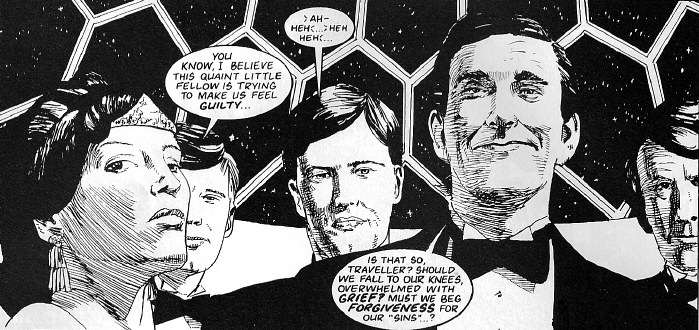 | | | SCRIPT: Warwick Gray
ART: John Ridgway
LETTERS: Simon Weston
EDITOR: Gary Russell ISSUES: 211
COVER DATES: April 1994 The Doctor arrives uninvited at a victory party held by an Eternal called Lord Prospero. First he tells the being of a race of Ephemerals destroyed by interference from their gods the Eternals. Upon hearing their indifference, he then gives Prospero a gift - a small crystal, but it is a trick, and when the crystal shatters the Eternals are embraced by the space-time vortex and made mortal. Knowing now that they will die, the Doctor advises them to make the most of their lives. |
|
 |  | | YOUNGER AND WISER |
|  |  |  |  | | SCRIPT: Warwick Gray
ART: Colin Andrew
LETTERS: Amer Anwar
EDITOR: Gary Russell COVER DATE: Summer 1994 The Doctor returns to meet the cybernetic nervous system known as Xenith who he last encountered in his first incarnation. Back then he allowed his companions’ fear to cloud his judgement, but now he realises it was simply Xenith trying to communicate. After speaking to Benny about whether or not he should repair the computer’s circuits, he does so and spends a lovely evening in the company of good friends. | | | | ALTERED VISTAS SAYS:
As a companion piece to the First Doctor strip Are You Listening?, this oddity still feels insubstantial. The idea of linking stories across two Doctors is a neat one, but sadly there isn’t enough plot here to sustain even half of the strip’s four pages. You can read about the other half of the story here.
|
| |
 |  | | PLASTIC MILLENIUM |
|  |  |  | | SCRIPT: Gareth Roberts
ART: Martin Geraghty
LETTERS: Elitta Fell
EDITOR: Gary Russell COVER DATE: Winter 1994 The Doctor and Mel celebrate the turn of the Millennium at a party organised by Alisha Hammerson of Hammerson Plastics for the country’s top businessmen. But Alisha is an Auton intent on taking over the world through duplicates of the top businessmen, but the Doctor has given Mel a phial of antiplastic which she uses to dissolve the Nestene’s energy sphere. | | | | ALTERED VISTAS SAYS:
Apparently, the Doctor hates excessive use of semi-colons, though I’m guessing he isn’t too bothered about the strip misspelling the word Millennium. The artwork looks very nice, apart from the likenesses of the Doctor and Mel; Mel sometimes looks like a man in drag, which is not how you could ever describe Bonnie Langford. The story is frothy and unchallenging, but just about works to hold the interest.
|
| |
 |  | | GROUND ZERO |
|  | | | 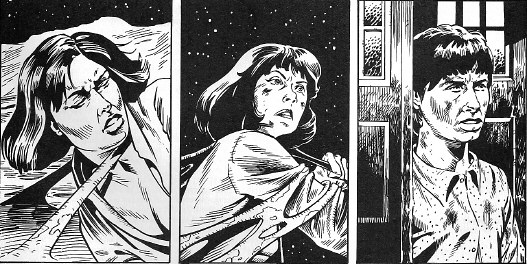 | | | SCRIPT: Scott Gray
ART: Martin Geraghty (pencils), Bambos Georgiou (inks)
LETTERS: Elitta Fell
EDITOR: Gary Gillatt ISSUES: 238 - 242
COVER DATES: May 1996 - August 1996
ON TV: The TV Movie Notting Hill Carnival, London, 29th August 2092, and Ace and the Doctor are in attendance. However, they are watched by members of the Threshold, shadowy beings from another dimension, who soon kidnap Ace then report to Isaac that the plan has been a success. Meanwhile, the Doctor glimpses his granddaughter Susan and runs after her, but it is a trap, luring him into the clutches of Isaac. Ace finds herself in a deserted Notting Hill, but she is not alone. With her are Sarah Jane Smith and Peri Brown. While the Doctor speaks to Isaac and learns that the Threshold is a business opening and closing dimensional gates for their clients, Ace, Sarah and Peri find themselves in a nightmare world of the collective unconscious. But the unconscious is inhabited by creatures that feed on fear itself. The creatures are the Lobri, clients of the Threshold. Ace, Sarah and Peri were chosen to enter the unconscious to feed the Lobri with their fear because they are already used to inter-dimensional travel. With that fear to make them strong, the Lobri will have power to escape the unconscious. Susan, it seems, was snatched by accident, the Threshold at first believing her to be just a schoolgirl.. However, the Lobri plan to destroy the unconscious when they leave it, which will leave humanity without a common bond - every person alien to the next. Slaughter will ensue, and the Lobri will feed off of it. The Doctor snatches Isaac’s ring with which he opens the dimensional gates and escapes with Susan back to the TARDIS. By linking the ring into the TARDIS’ circuits, he can enter the unconscious, but as the unconscious begins to break down and violence erupts all over the world, it looks like the effort of entering the place will tear the TARDIS apart. Ace frees herself and Sarah from the Lobri and they are about to free Peri when the TARDIS arrives. However, Isaac uses his ring to paralyse the Doctor. He tells Ace to leave him, but she won’t and, when the Lobri move in around her, she detonates a can of Nitro-9, destroying all but one of the Lobri but killing herself. The Doctor pilots the damaged TARDIS back to Notting Hill where the final surviving Lobri has appeared. He confronts it and allows it to feed off his anger, but this is only a trick to hold its attention long enough for Susan to land the damaged TARDIS in the centre of the creature, killing it immediately. The Doctor then swears vengeance on Isaac and the Threshold before returning Peri, Sarah and Susan to their own time streams. |
| |
 |  | | THE LAST WORD |
 |  | | SCRIPT: Gareth Roberts
ART: Lee Sullivan (art and colour)
LETTERS: Roger Langridge
EDITOR: Alan Barnes ISSUE: 305
COVER DATE: June 2001 The Doctor sends Benny back to 1981 to join a New Romantic band, while Ace fights Chelonians in the 57th century. They're supposedly there looking for distortions in history, but really the Doctor sent them there to change history, thus drawing the Timewyrm out of hiding by giving it a food source. He has built a device to trap the Timewyrm forever, but it appears to fail because the Timewyrm has shed its physical existence and now exists only in Puterspace. Instead it casts the Doctor into Puterspace to drift forever, but when it then attempts to feed on the time distortion Benny and Ace have caused, it finds that doing so returns history to normal and tt is cast back into Puterspace, where the waiting Doctor reveals that his device has altered the structure of the Timewyrm's data stream so it can never emerge into the real Universe again. He then uses the device to transport himself back to the TARDIS, where the irritated Ace and Benny watch as he starts to write a novel based on their adventure. |
| |
 |  | | ALTERED VISTAS SAYS:
If you’ve read them, this strip probably parodies the New Adventures quite well. If you haven’t then it’s a mildly enjoyable and attractively illustrated tale with something of a hurried and weak ending. Of course, as this strip and this particular issue of Doctor Who Magazine celebrate ten years of Virgin’s New Adventures, perhaps it doesn’t matter if the uninitiated don’t get it.
|
| |
 | | |  |
|  |  | | SCRIPT: Tony Lee
ART: Kelly Yates, Kris Carter and Charlie Kirchoff (colour)
LETTERS: Richard Starkings
EDITOR: Denton J. Tipton ISSUE: 4
COVER DATE: November 2008
REPRINTS: Doctor Who: The Forgotten, graphic novel, IDW April 2009. This story is a mini-story told within a much larger tale. To see the larger tale, click here. The Doctor and Ace have landed on Agrovan Seven. The war between the Strykes and the Marats has lasted fifteen hundred years, but someone has given the Strykes a Gallifreyan biological weapon. The Doctor and Ace are captured by the Strykes but escape and soon meet up with the Marats who are falling ill. However, the Doctor has the cure and gives it to them. | | | ALTERED VISTAS SAYS:
As vignettes in The Forgotten go, this one has a lamer plot than most, and weaker and less well characterised dialogue too, and, although the colouring is gorgeous, the actual art bears no resemblance to either Sylvester McCoy or Sophie Aldred, which is rather a shame, though does at least bring the Seventh Doctor’s comic strip exploits full circle. Something of a wasted opportunity.
|
| |
|
|